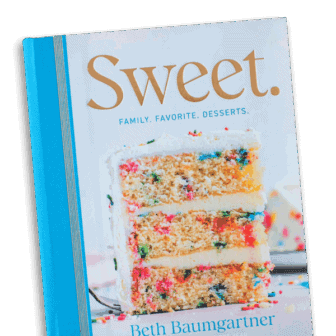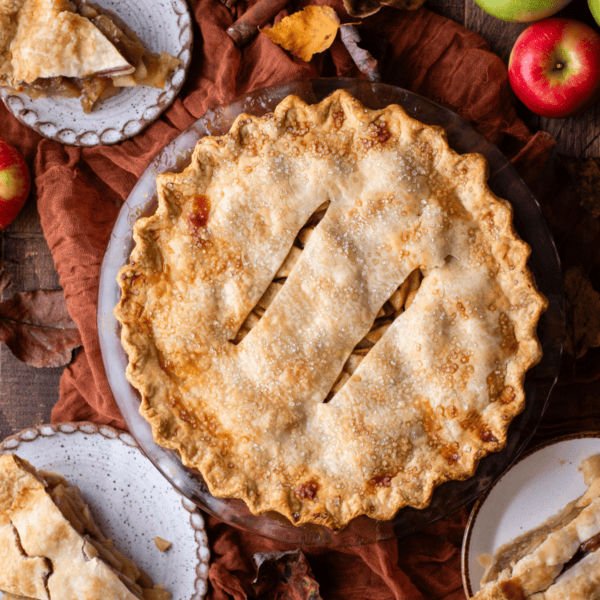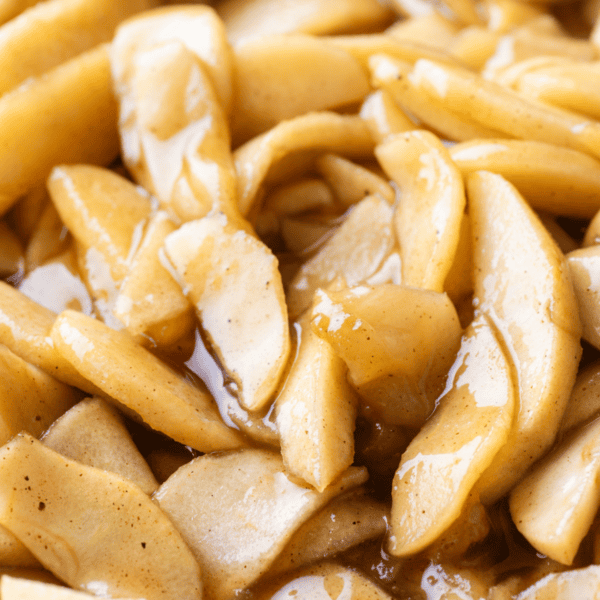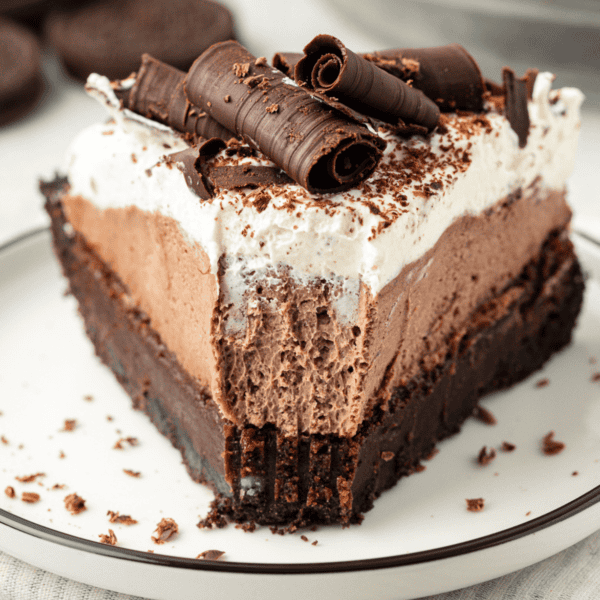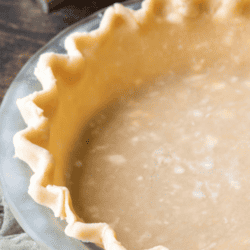This post may contain affiliate links. Please read our disclosure policy.
After spending 4 weeks in the kitchen perfecting the perfect gluten-free pie crust recipe, I’m sharing it with you! Plus, I’m sharing all my best tips and things I did wrong along the way, so you can make easy gluten-free pie crust the first time!
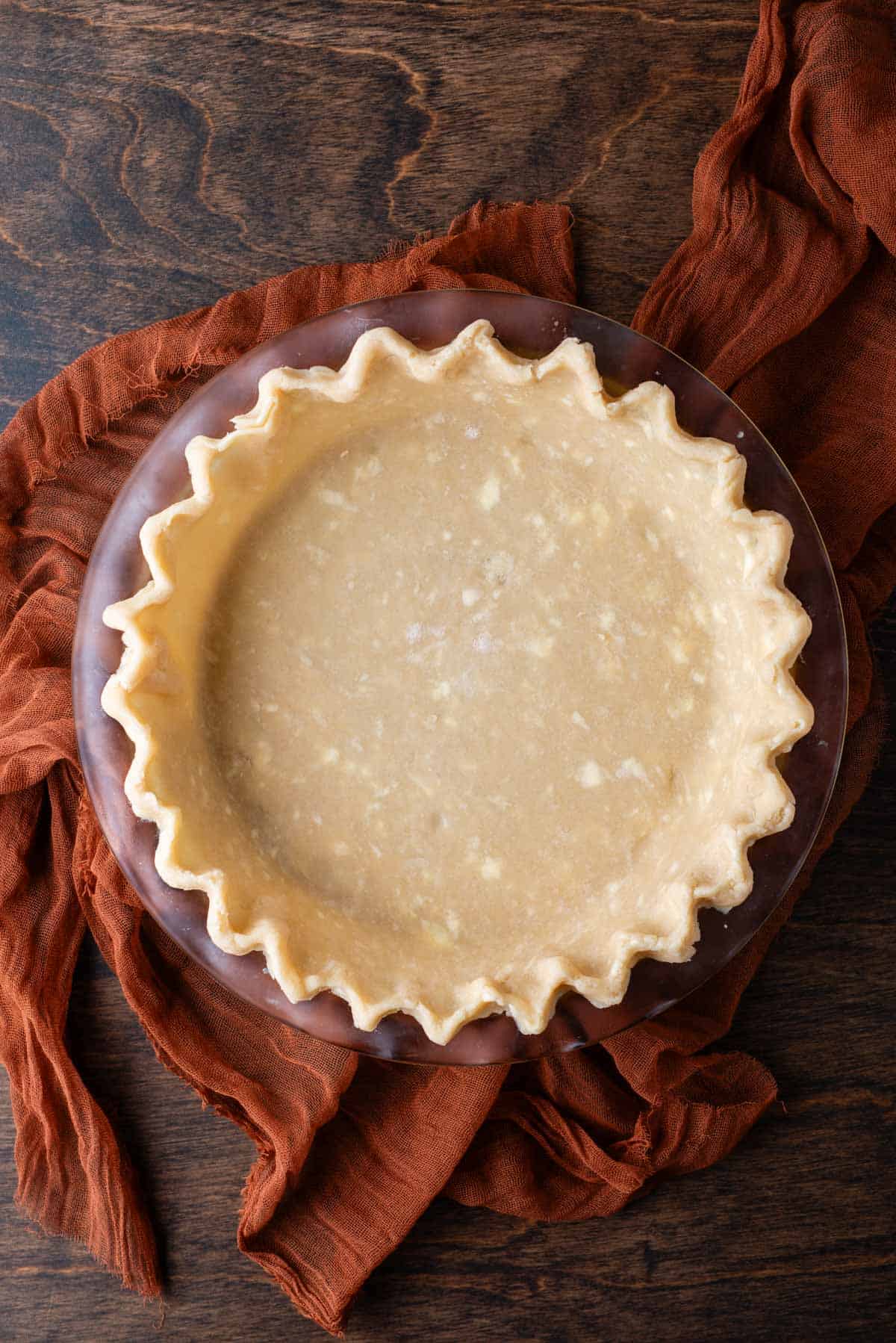
My Perfected Gluten Free Pie Crust Recipe
Because I have been gluten free for 16 years (since 2006), I actually take the time to test all of my recipes using gluten free flour, as opposed to other food bloggers who normally just add gluten free instructions to their recipes. With all of my gluten-free baking, you can trust that this is a true, tried and tested, homemade gluten-free pie crust.
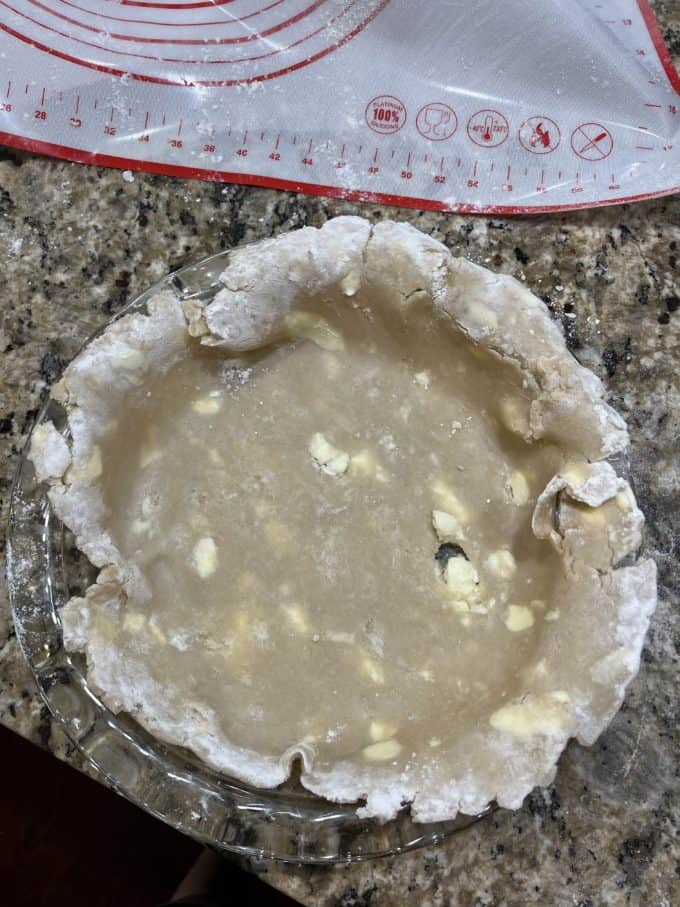
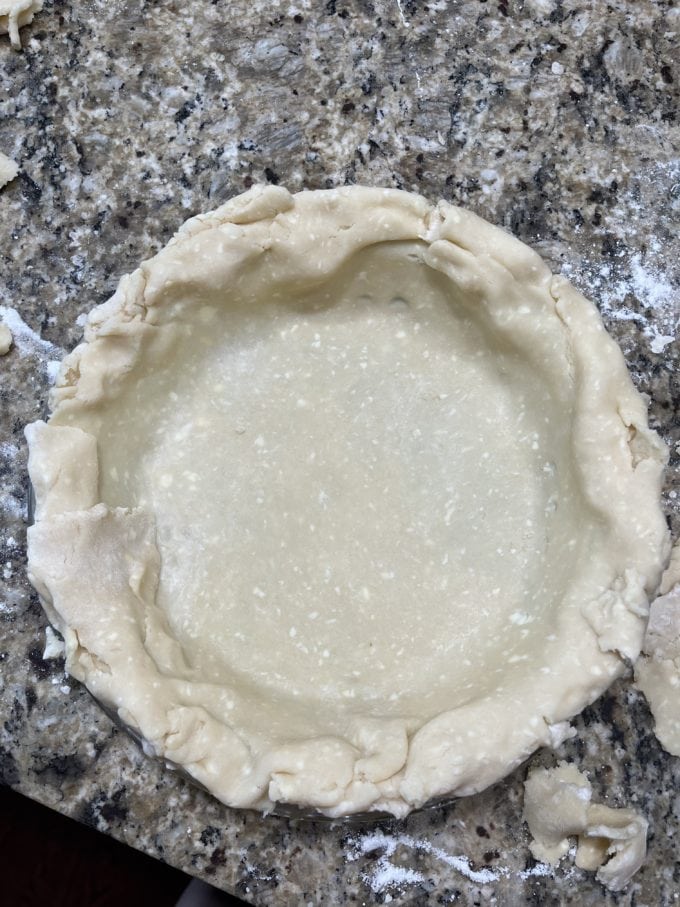
I am excited to be your pie crust coach and help you make the best gluten-free pie crust! Not long ago, I was a beginner at pie crust too. Then, I started a month-long journey of perfecting my pie crust recipe. I started with zero experience and I’m here to tell you that even if you have zero baking experience, it’s entirely possible for anyone to learn how to make flaky pie crust from scratch.
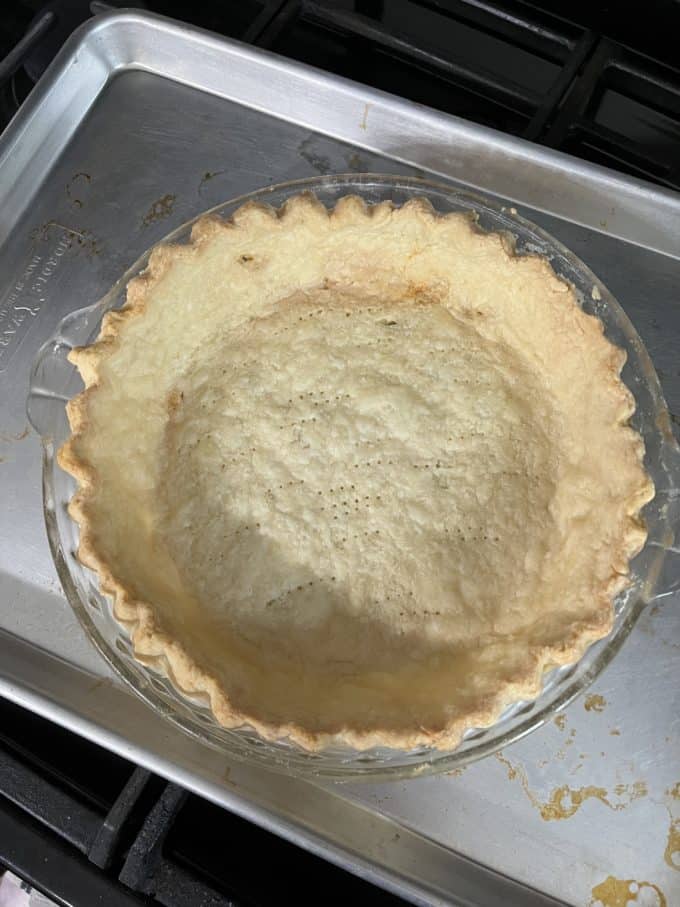
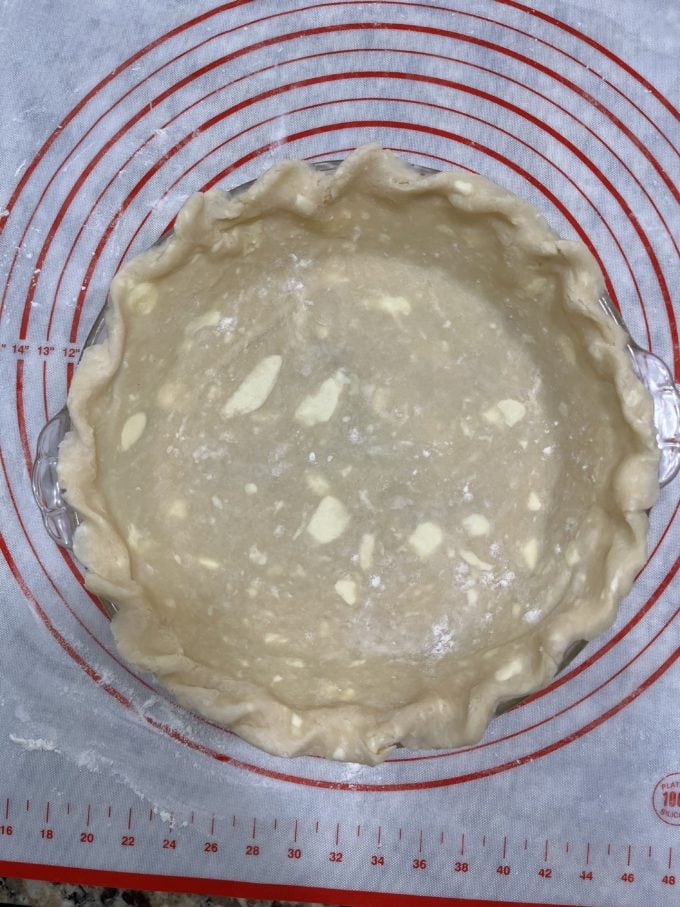
I never had much experience with making homemade pie crust, until this year when I decided to challenge myself and learn how to make the perfect gluten-free pie crust dough. If you follow me on Instagram, you may have seen my initial fails at making homemade pie dough.
They say you either win or you learn, and after my first epic fail, I learned the important lesson that you should not knead the dough by hand. Next, I called in a local friend who had grown up making homemade pie crust with her mom and grandmother. Thankfully, she was up for giving me an in-person lesson.
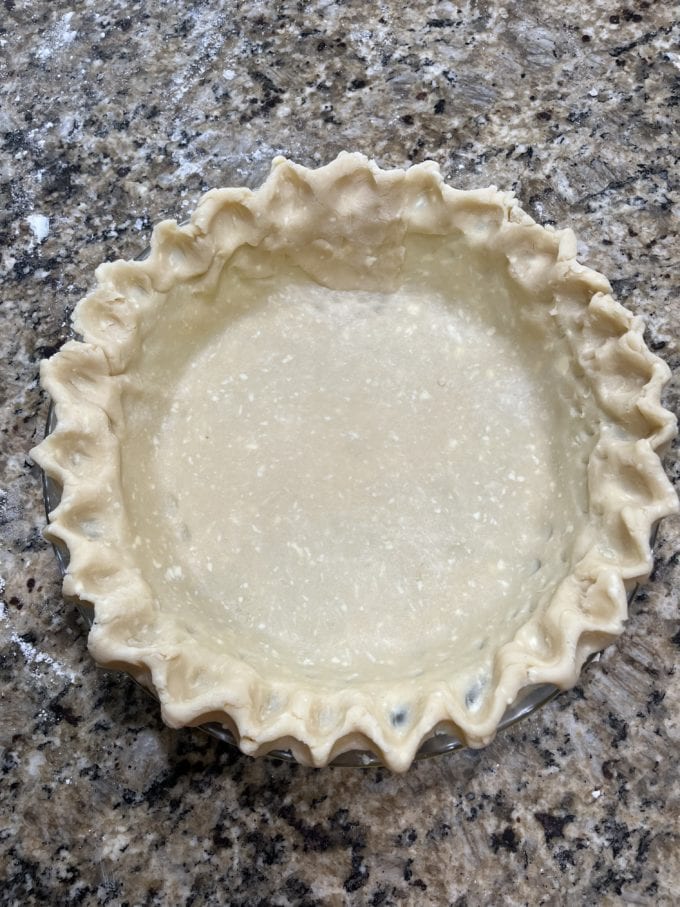
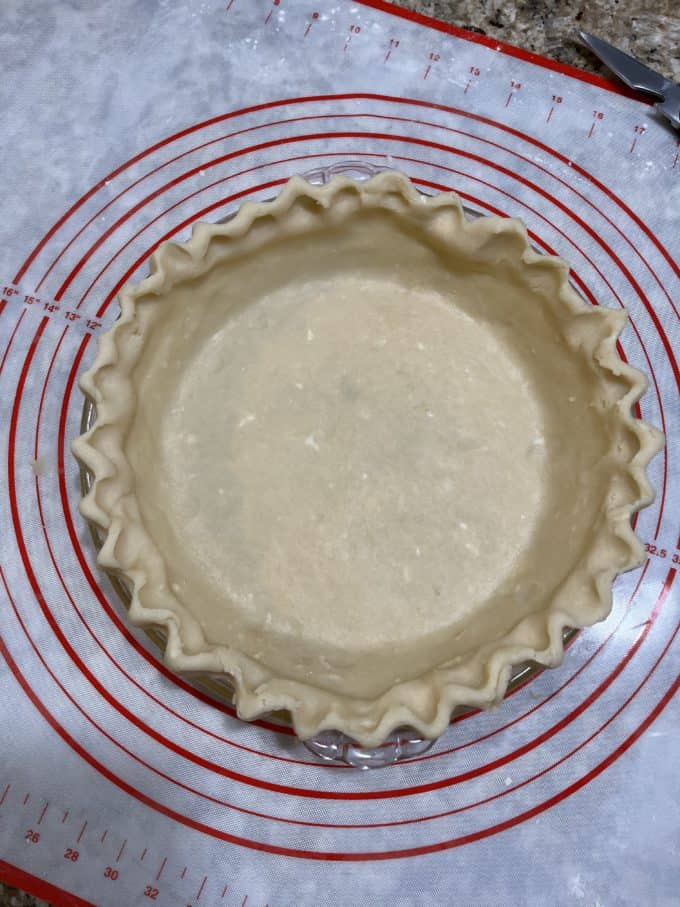
Thanks to my friend and the knowledge she shared from the generations before her, I was able to learn what gluten-free pie dough should look and feel like when it has just enough water to bring it together, how to roll out of the dough and how to flute the edges correctly.
After my intensive 4 week study into making, re-making, testing, rolling and baking the perfect pie crust, I am ready to share it with you with easy-to-follow steps so you don’t have to make the mistakes I did!
Recipe For Gluten Free Pie Crust Ingredients
This gf pie crust recipe will take all your homemade pies to the next level. It’s made with simple ingredients that you likely already have on hand. Get the full recipe with ingredients and instructions in the recipe card below:
- Gluten Free All-purpose flour: I recommend a high quality 1:1 gluten free flour that contains xanthan gum. I personally use King Arthur Gluten-Free Measure for Measure flour.
- Salt
- Granulated sugar: If you prefer, you can omit the 1 tbsp of granulated sugar, but I promise it doesn’t make the crust sweet.
- Unsalted butter
- Vegetable shortening
- Ice cold water: Believe it or not, you can use vodka in place of the ice water!
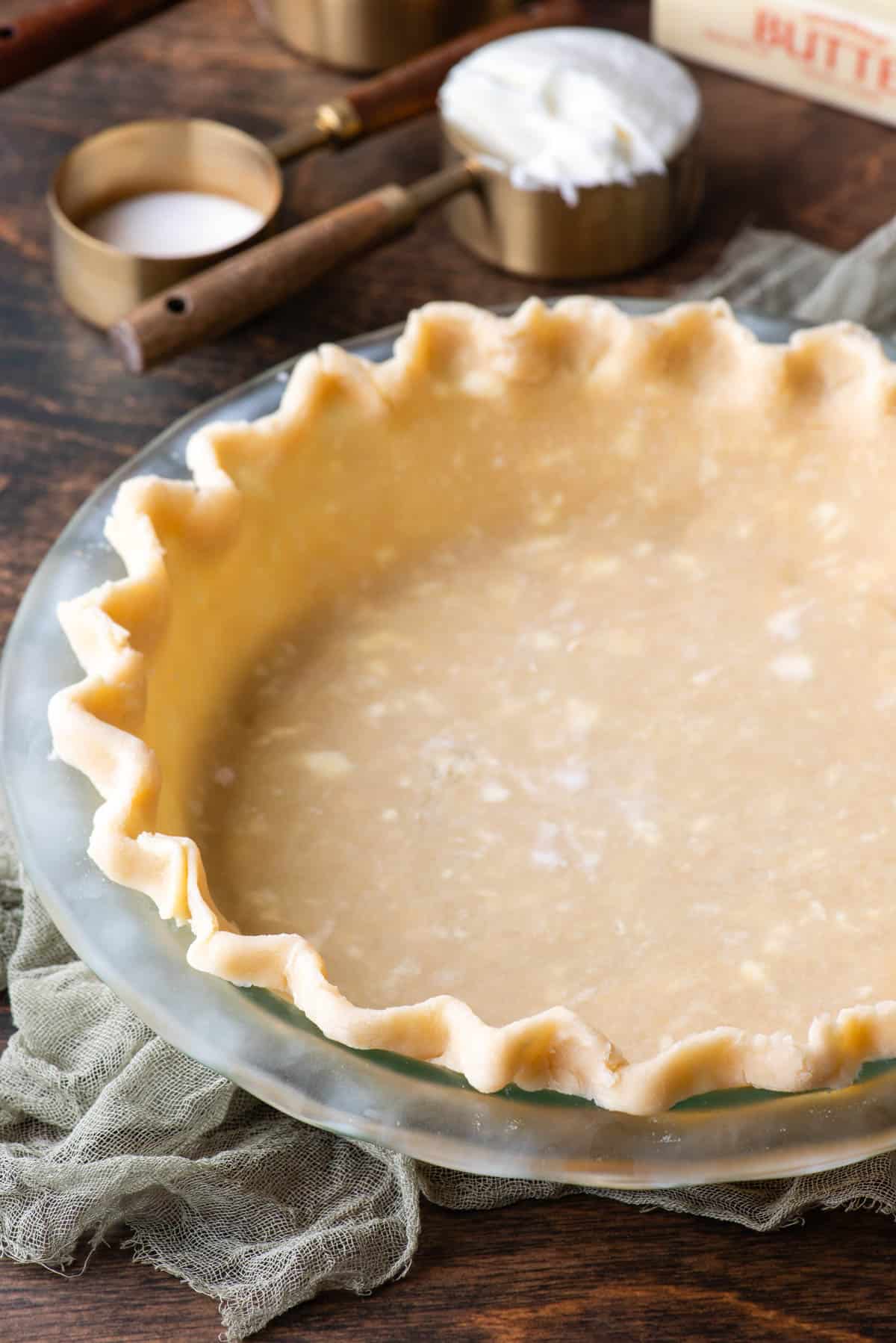
How to Make Gluten Free Pie Crust
The month I spent perfecting this flaky gluten-free pie crust allowed me to write out this simple step-by-step guide for you, making it easy to follow and fool proof. Get the full recipe with measurements and ingredients in the recipe card below:
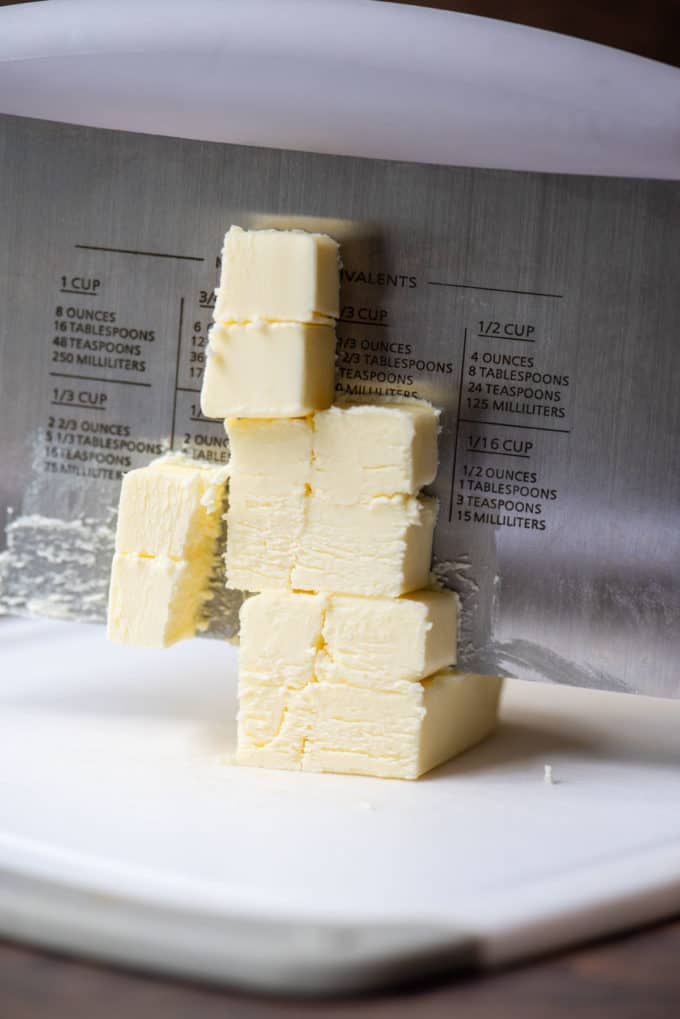
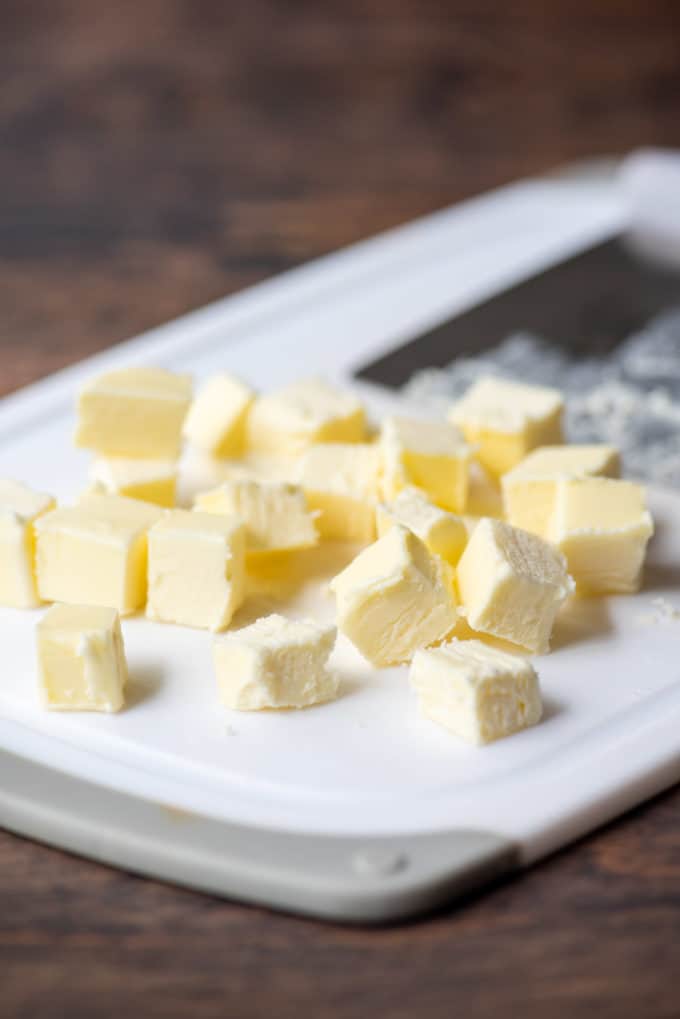
- Chill the Butter and Shortening: Start by cutting the butter and shortening into small cubes. Place in a container or on a plate and put in the fridge to chill for at least 30 minutes. I recommend using shortening sticks so it’s easier to cut into pieces. If using a tub of shortening, you can portion the ⅔ cup into about tablespoon size pieces.
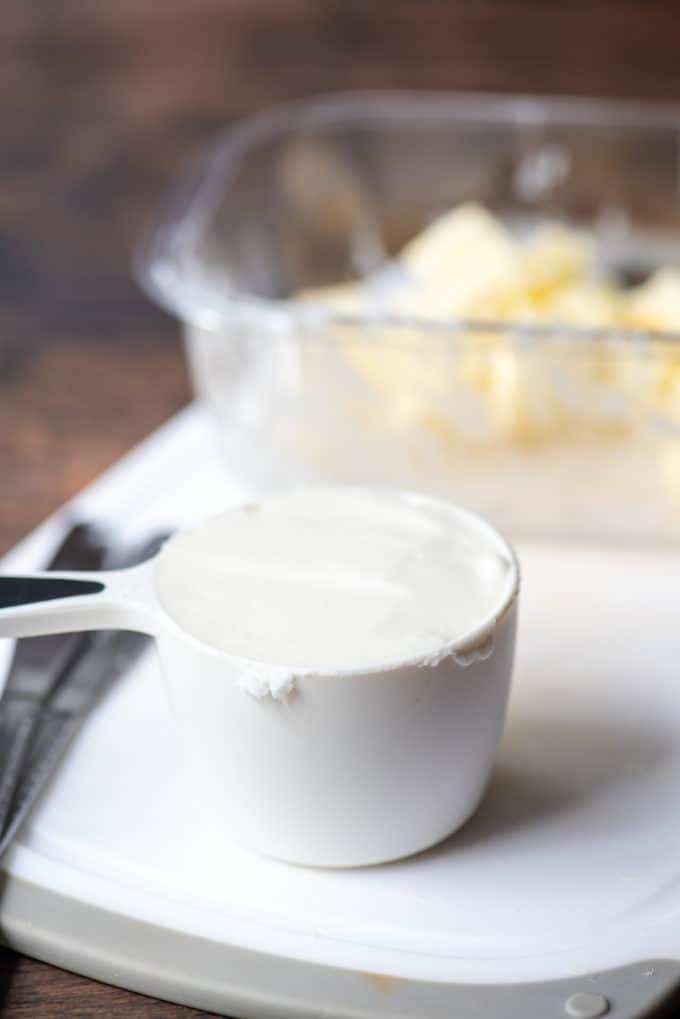
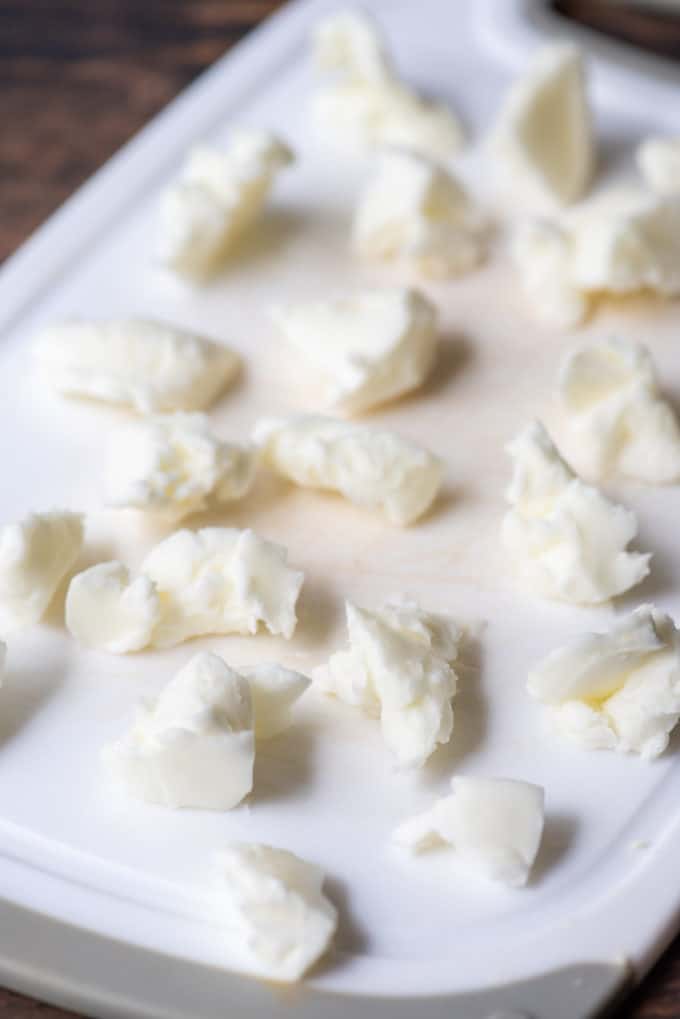
- Combine Dry Ingredients: In the food processor, add the 2 1/2 cups of all-purpose flour, 1 teaspoon of salt, and 1 tablespoon of granulated sugar. Pulse a few times to combine the dry ingredients.
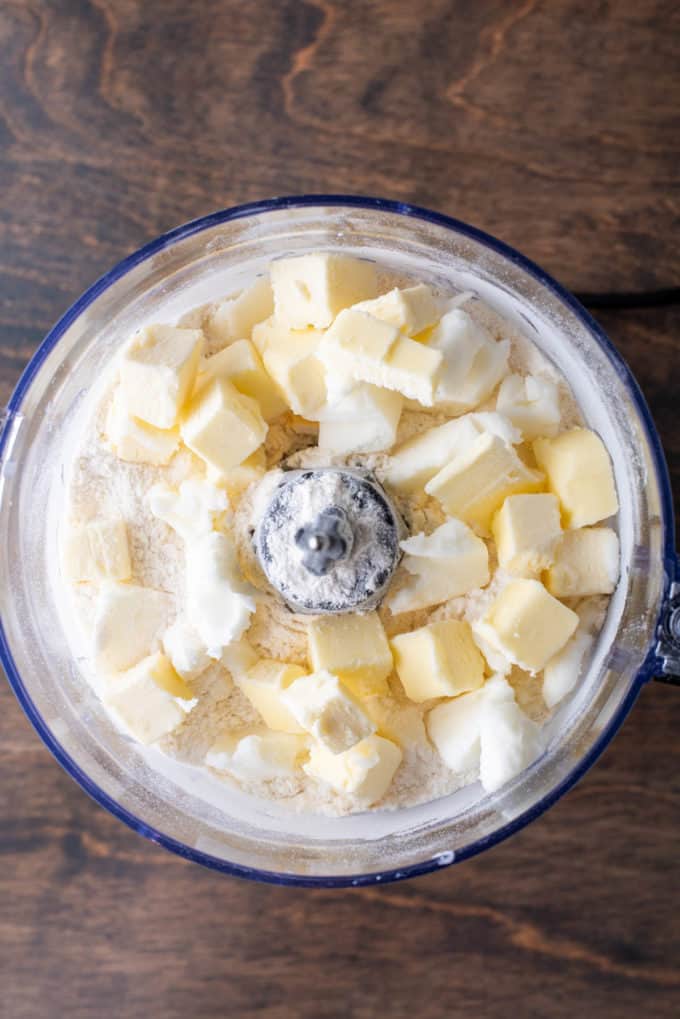
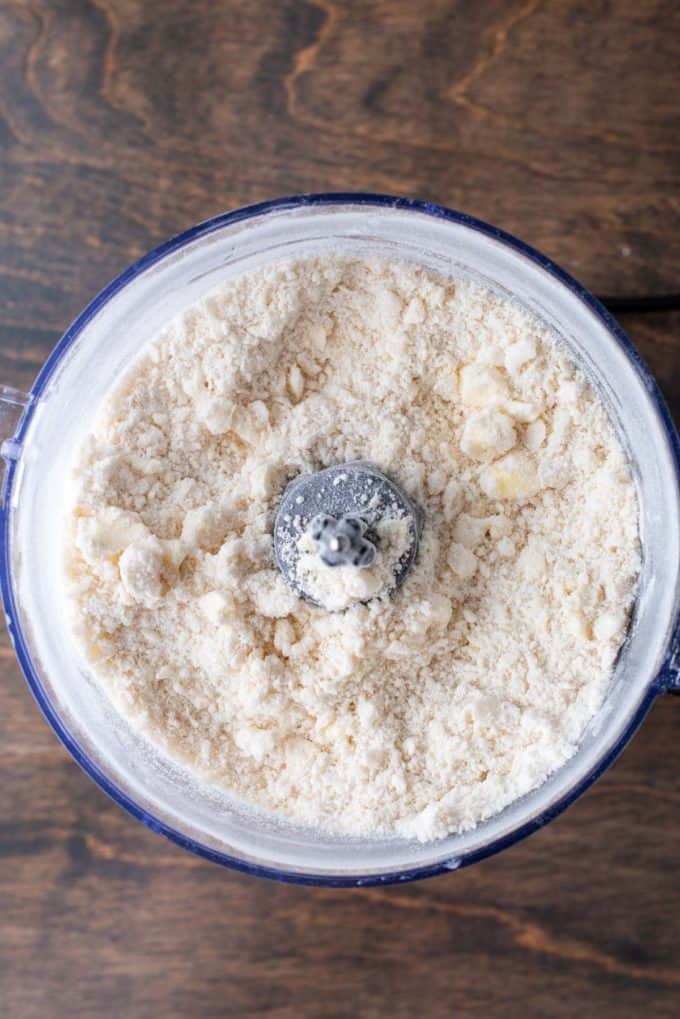
- Add Butter and Shortening: Add the 6 tablespoons of cold unsalted butter cubes and the chilled vegetable shortening chunks into the food processor. Pulse until the mixture resembles coarse crumbs with some pea-sized pieces of butter and shortening remaining. This should take about 10-15 one-second pulses.
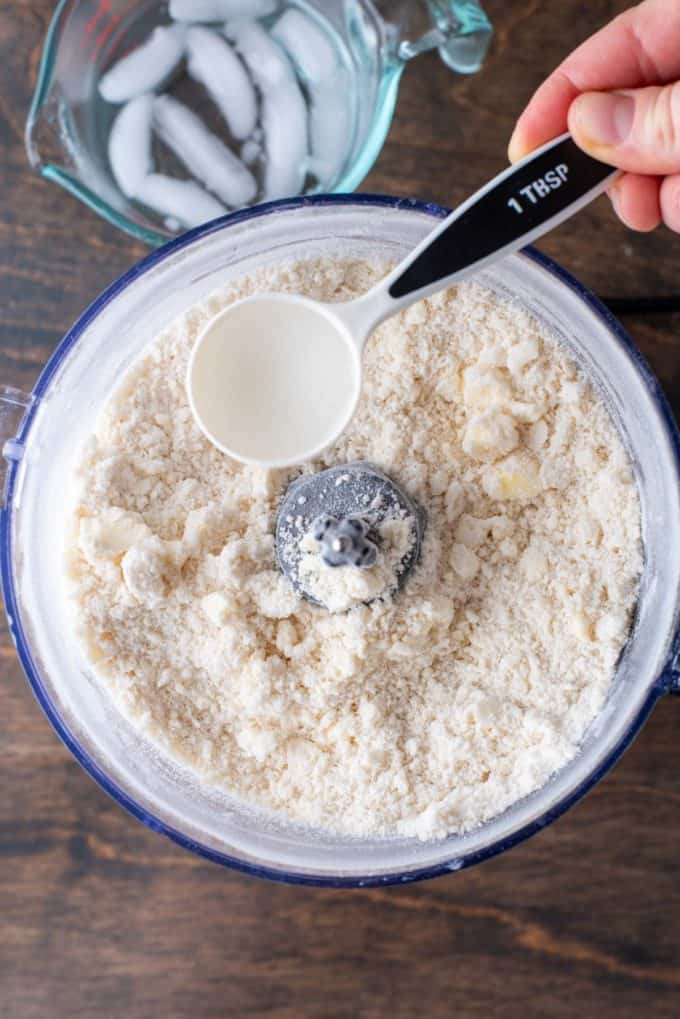
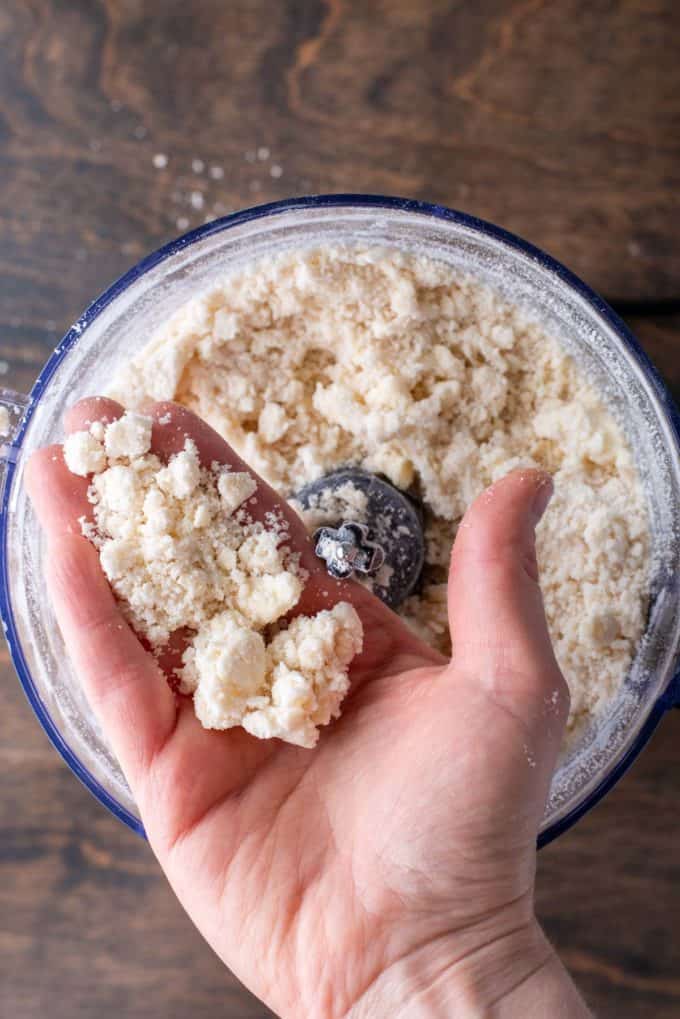
- Add Ice Water: drizzle in the ice-cold water, start with 4 tablespoons, continue processing until the dough begins to clump together. You can test the dough by pinching it; if it holds together, it’s ready. If it’s too dry, add more water, 1 tablespoon at a time, and pulse briefly until the dough reaches the right consistency.
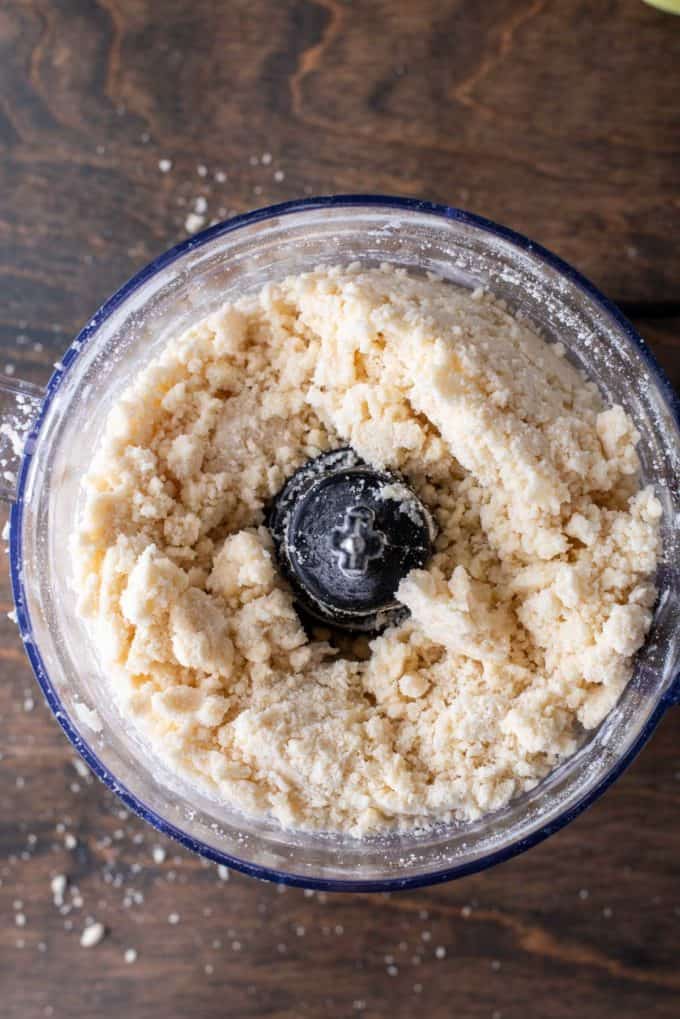
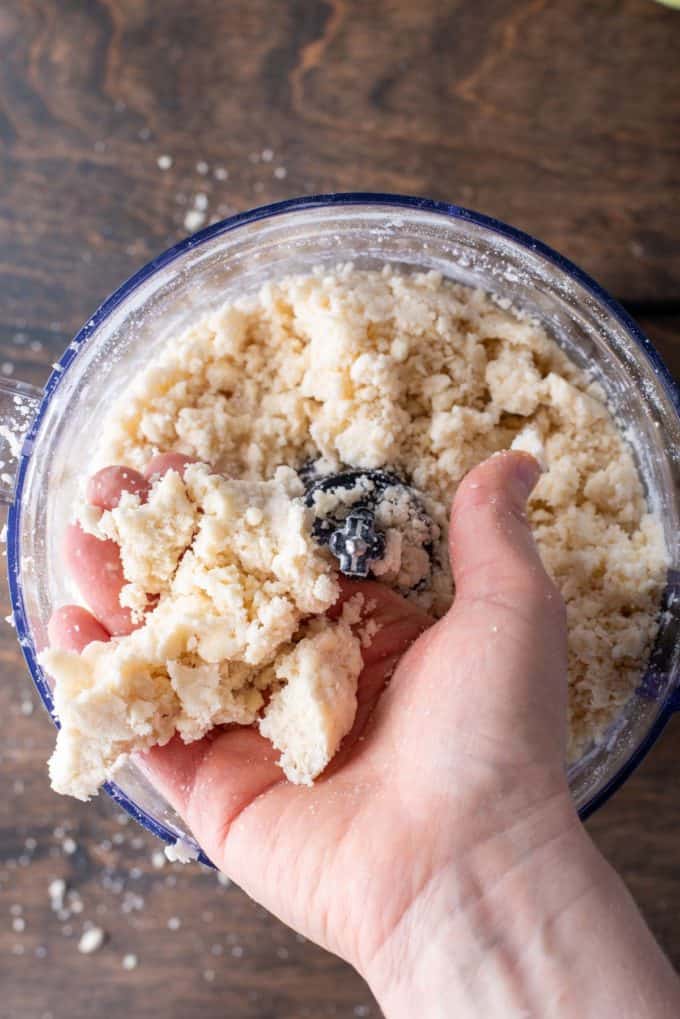
- Form Dough: Turn off the food processor and carefully remove the dough from the bowl. Place it onto a clean surface, such as a large piece of plastic wrap.
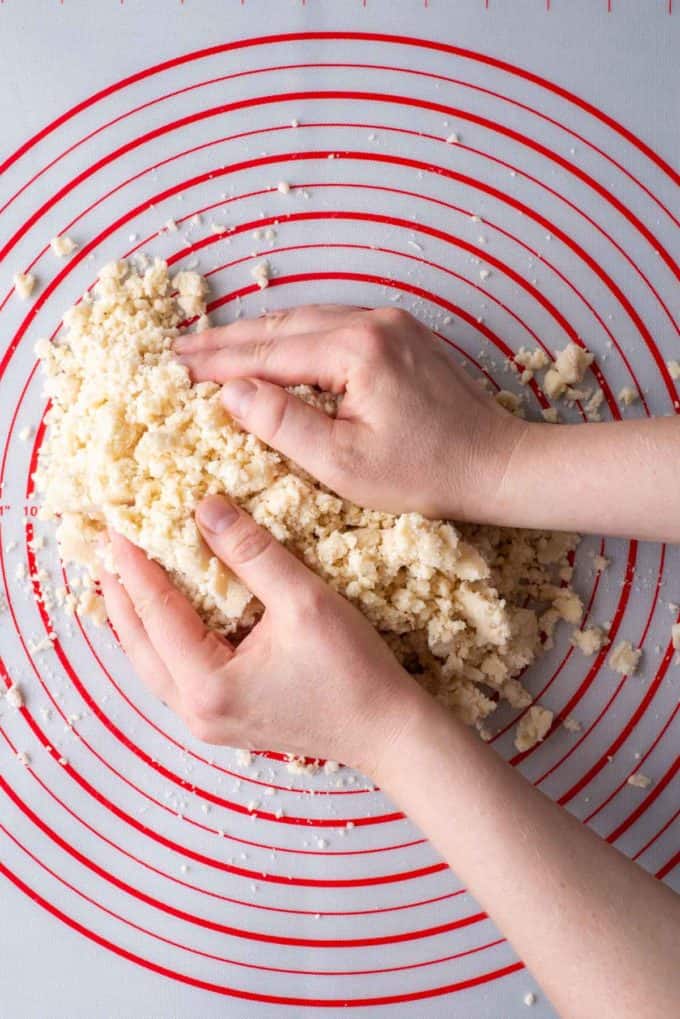
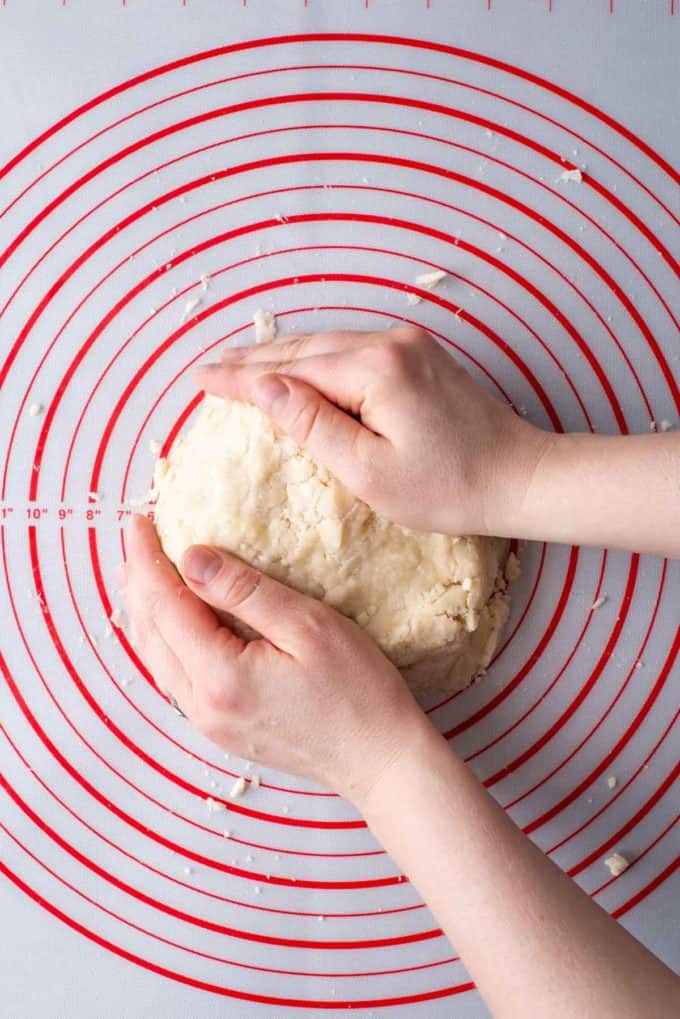
- Shape into Discs: Divide the dough into two equal portions. Shape each portion into a flat disc. This makes it easier to roll out later. Wrap each disc tightly in plastic wrap and refrigerate for at least 60 minutes or until firm. You can refrigerate for up to 4 days. You can also freeze one of the discs for future use if you’re only making a single-crust pie.
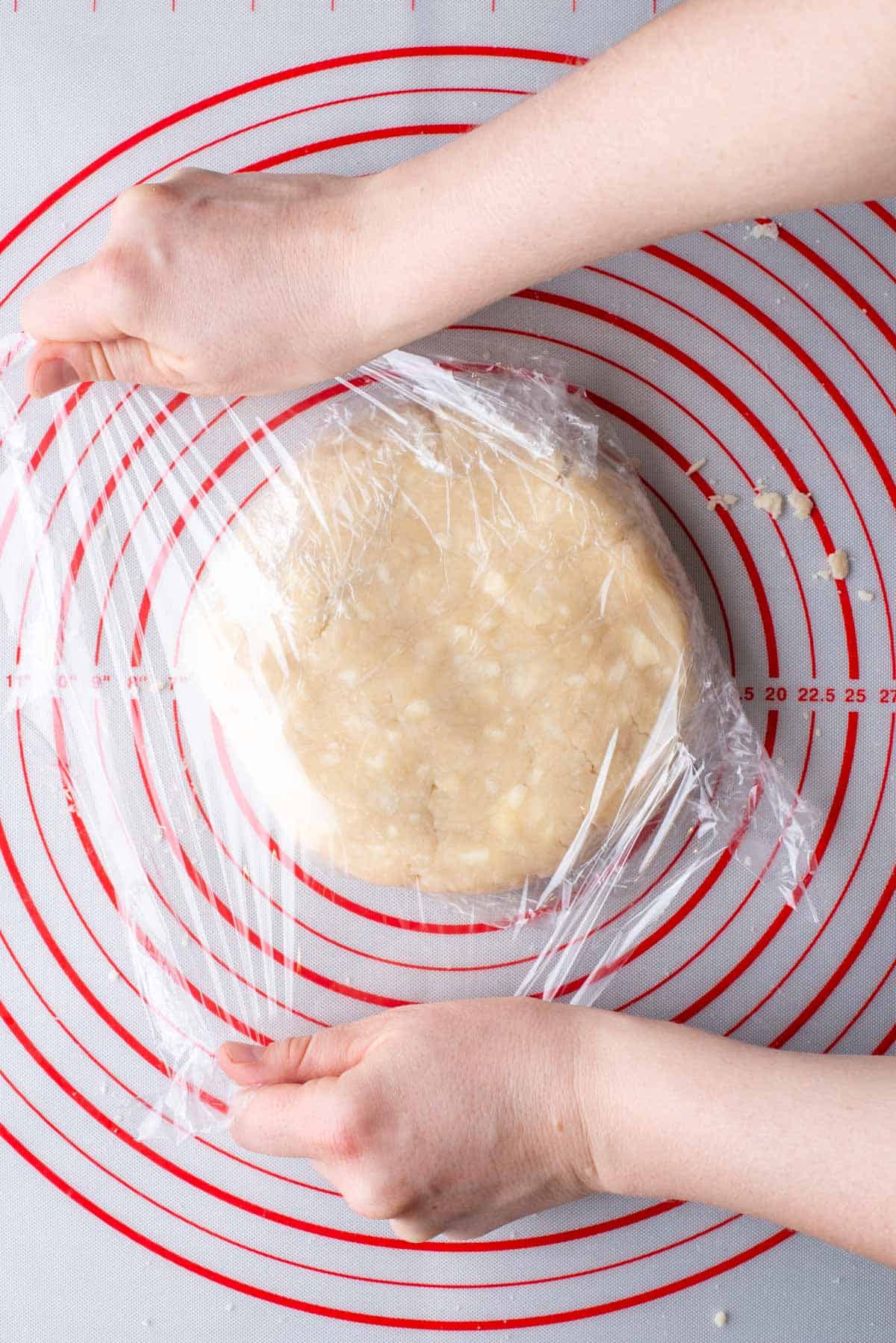
ROLLING OUT THE DOUGH
- Prepare Your Work Surface:Ensure your countertop or pie mat is clean and dry. Lightly dust it with all-purpose flour to prevent sticking.
- Take Out Chilled Dough: Remove one of the chilled dough discs from the refrigerator and let it sit at room temperature for a few minutes. This will make it easier to roll.
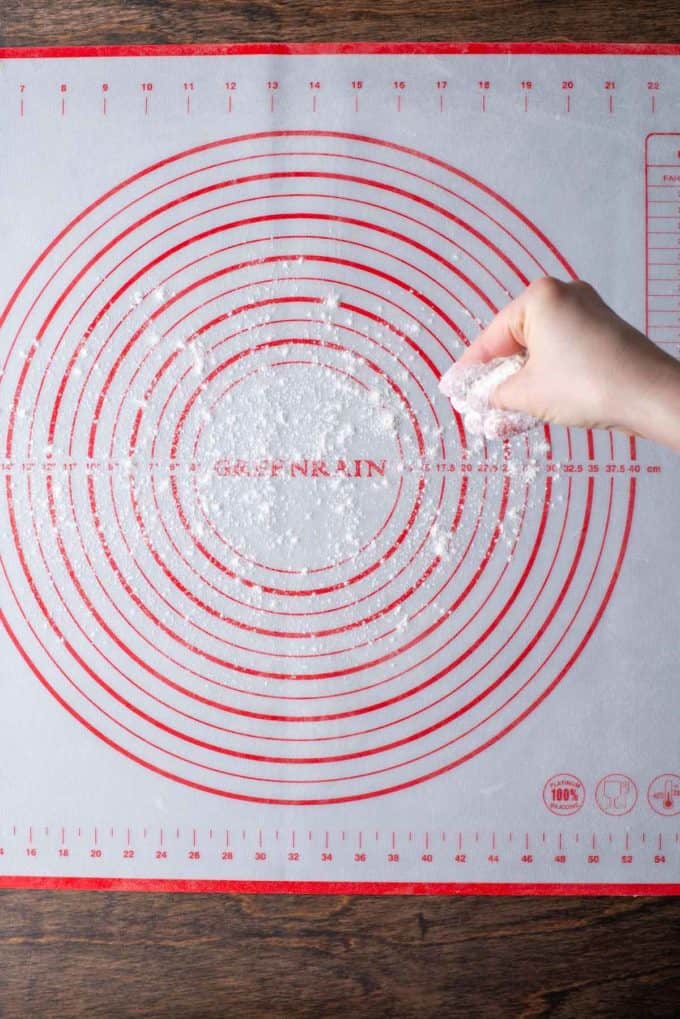
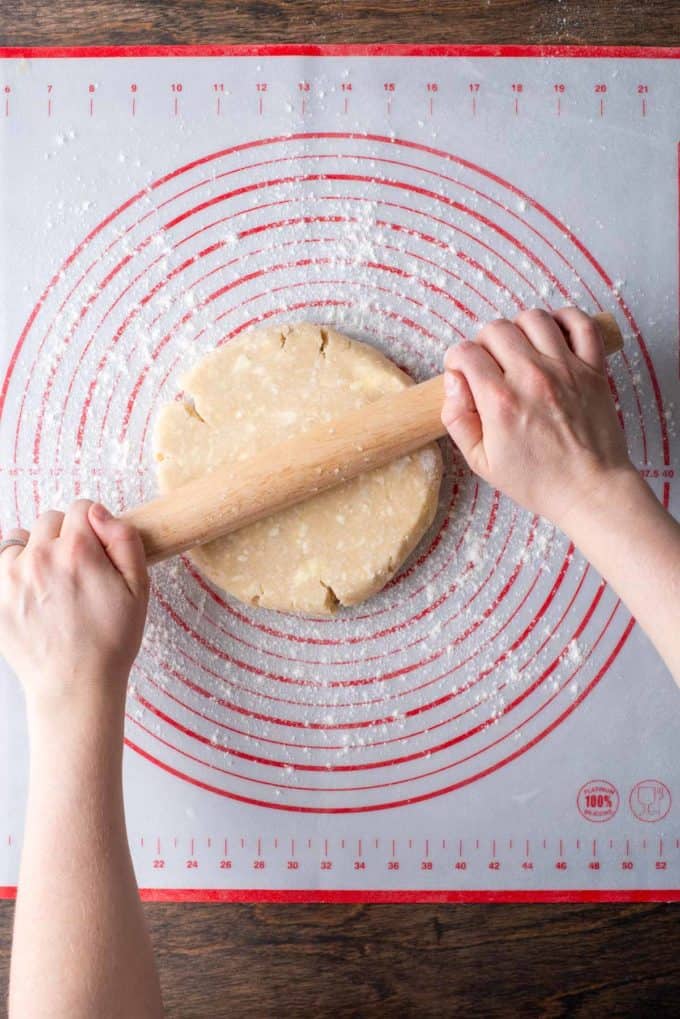
- Begin Rolling: Place the dough disc on the floured surface and use your rolling pin to gently press it down in the center. Start rolling from the center outward. Apply even pressure as you roll, working in all directions to maintain a roughly circular shape. If the dough cracks or splits during the rolling process, use your fingers to gently pinch it back together.
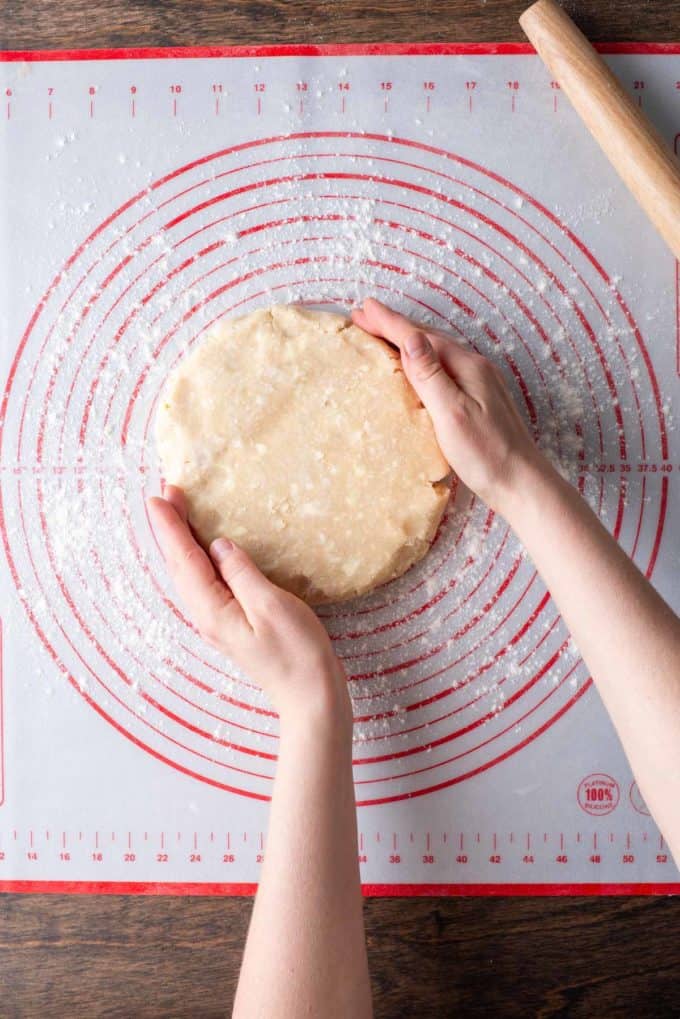
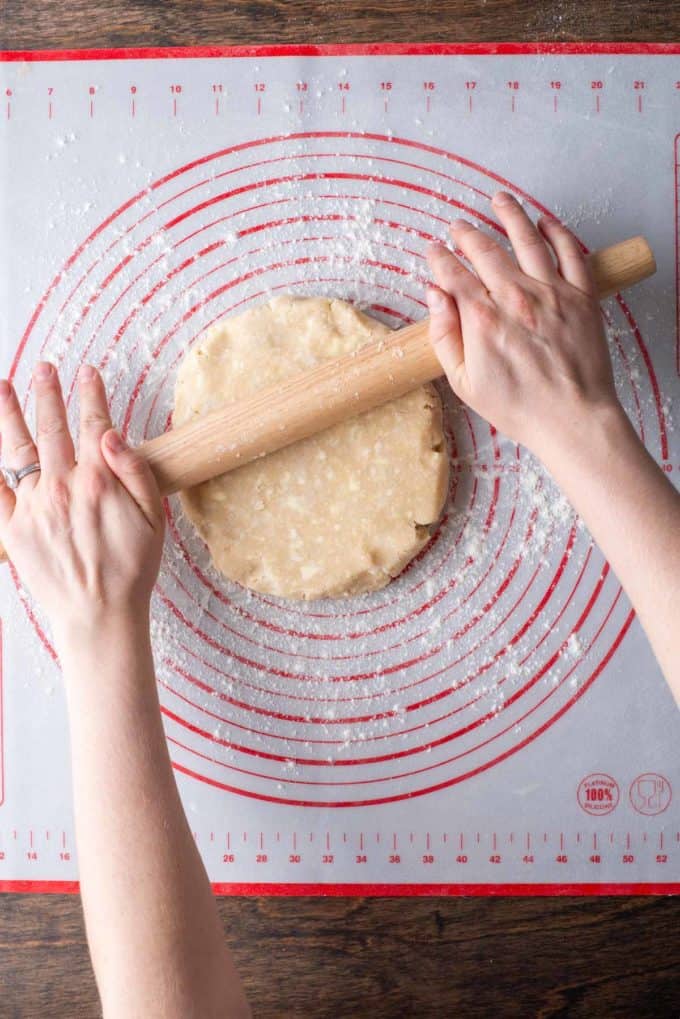
- Rotate the Dough: After each roll, rotate the dough a quarter turn. This helps ensure an even thickness and round shape, and prevents the dough from sticking to the surface. Continue rolling and rotating until the dough is about 6 inches in diameter.
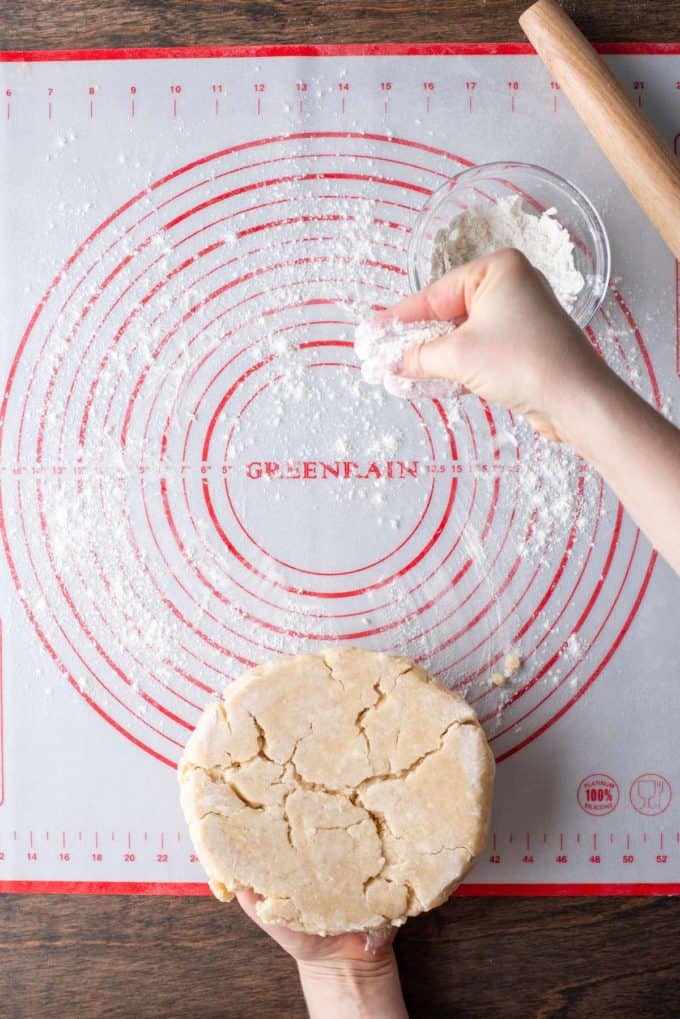
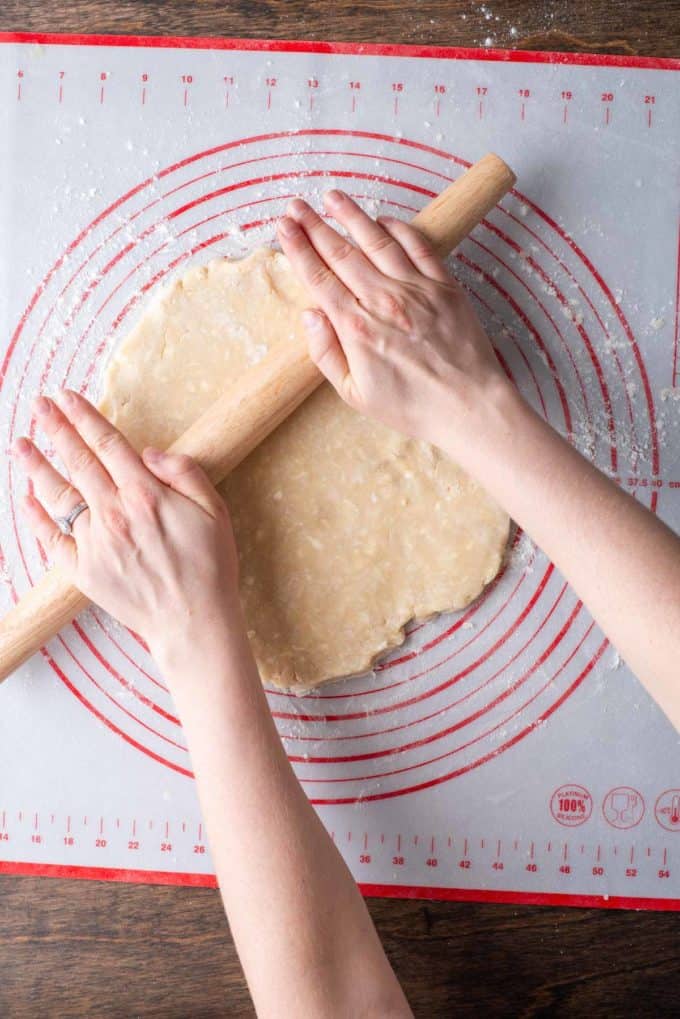
- Flip and Dust with Flour: Gently lift the dough from the surface using your hands, and flip it over. This prevents sticking and ensures even rolling. If the dough feels sticky, lightly dust it with more flour.
- Continue Rolling: Resume rolling from the center outward, rotating the dough as needed. Aim for an even thickness and gradually work your way to your desired size, typically 11-12 inches in diameter for a standard pie dish.
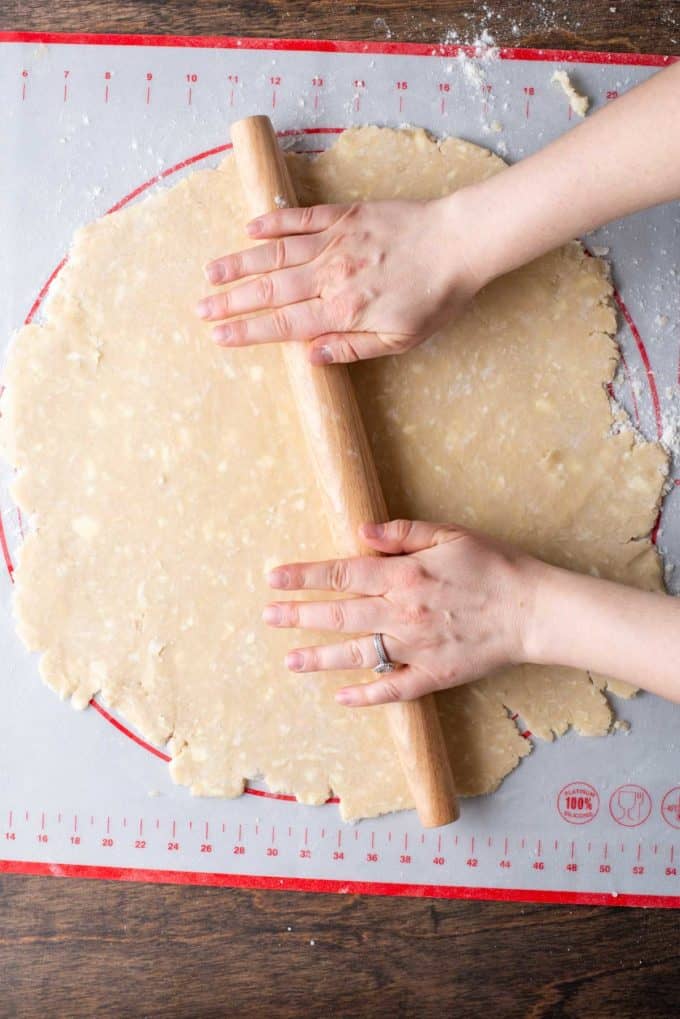

- Use a Pizza Cutter (Optional): For a perfectly round shape, consider using a pizza cutter. Place the cutter’s wheel at the edge of the dough, and cut around the perimeter to trim it into a precise circle. This also helps you visualize the exact size needed for your pie pan.
- Sprinkle with Flour: To prevent the dough from sticking to itself when rolled onto the rolling pin, sprinkle a little more flour over the surface of the dough.
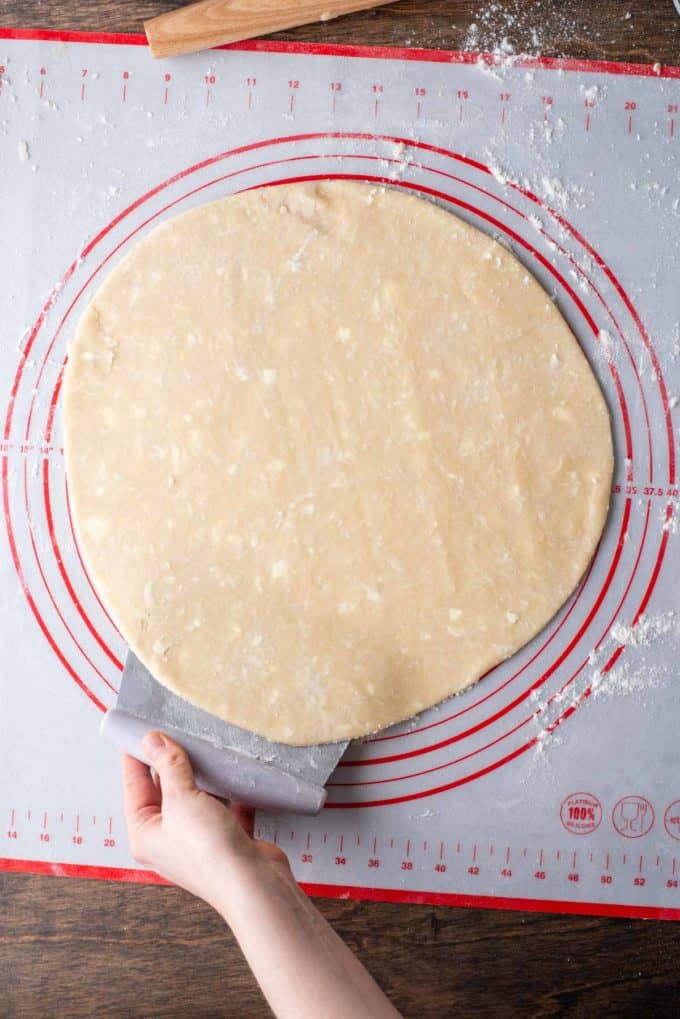
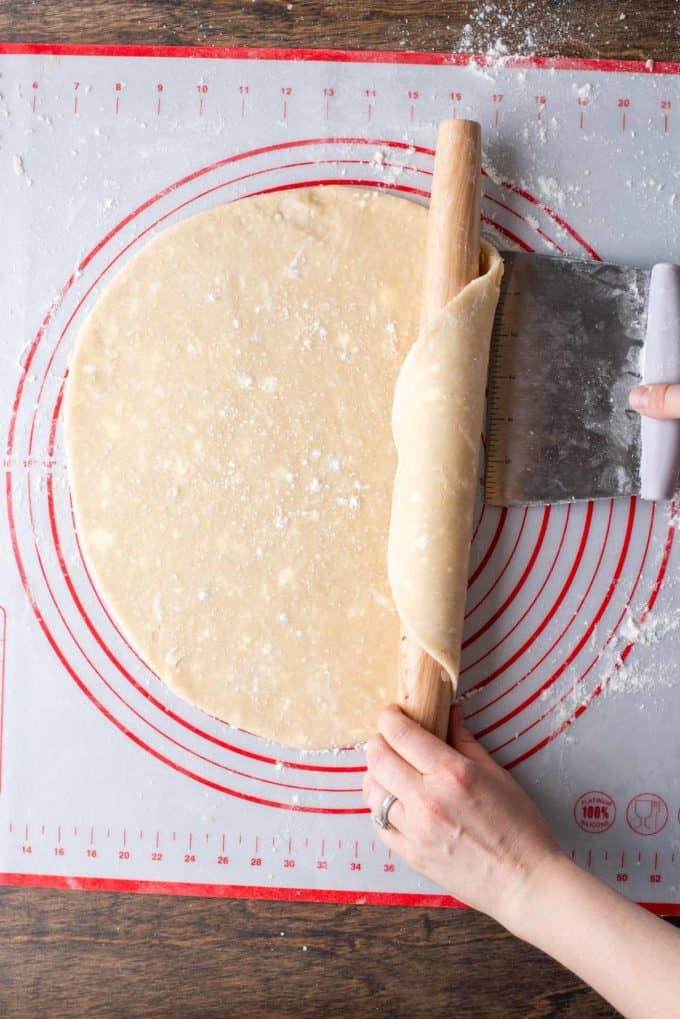
- Roll onto Rolling Pin: Carefully lift one edge of the dough and gently roll it onto your rolling pin. Start from one edge and continue rolling until the entire circle is wrapped around the rolling pin.
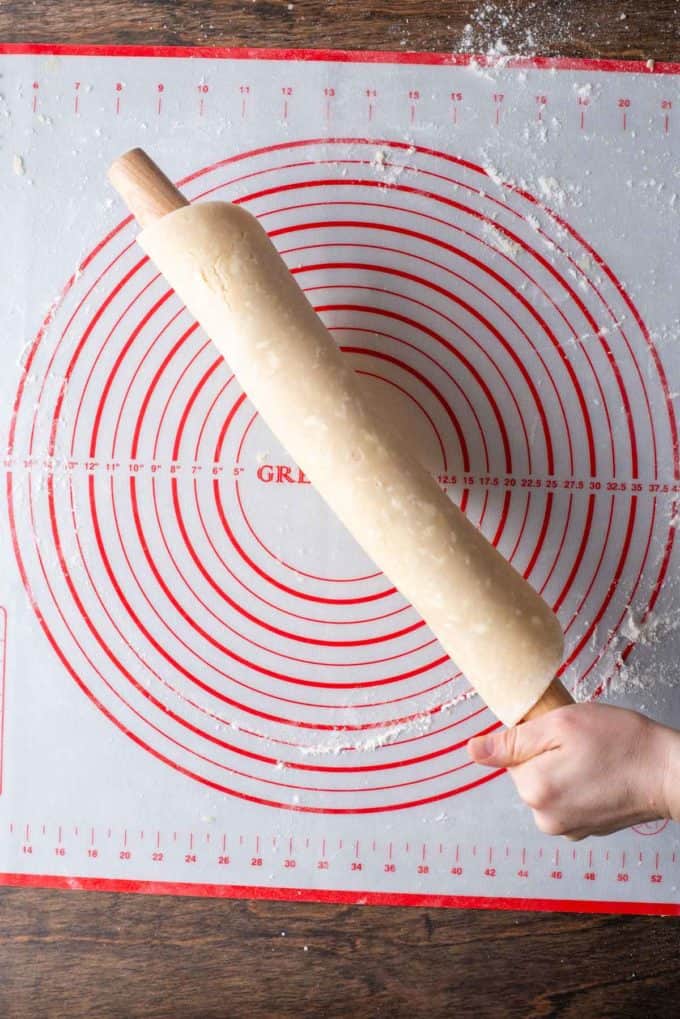
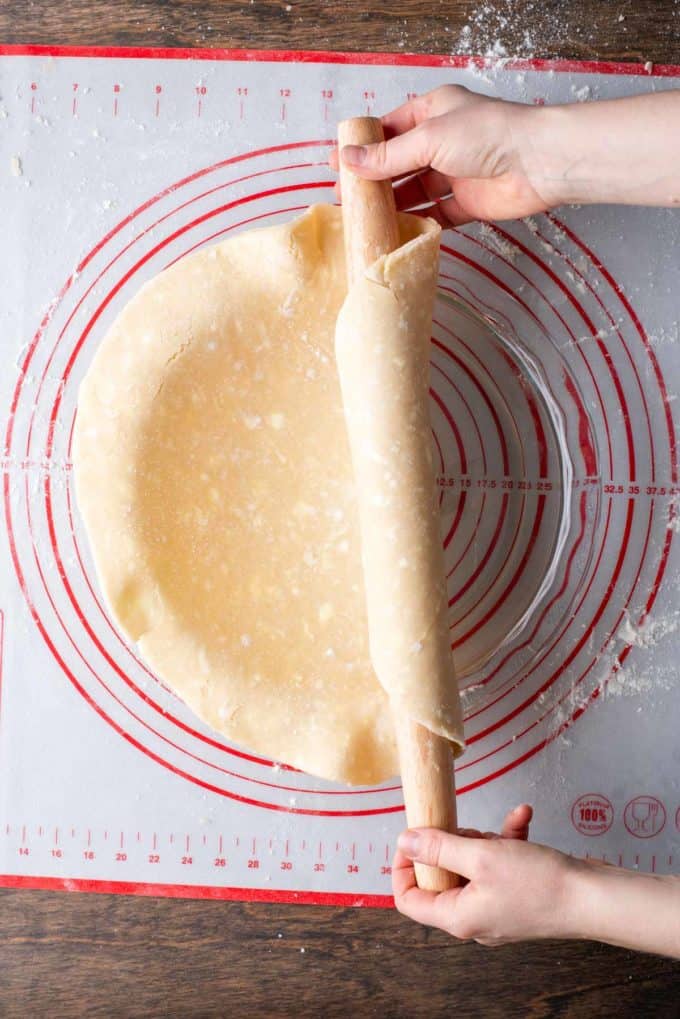
- Transfer to Pie Dish: Position the dough-covered rolling pin over your pie dish with the edge of the dough hanging over the side. Gently unroll the dough from the rolling pin into the pie dish, ensuring it covers the bottom and sides evenly.
- Trim Excess Dough: Trim any excessive overhang from the dough, leaving about 1/2 to 1 inch of overhang all around the pie dish. You can use scissors or a knife to do this.
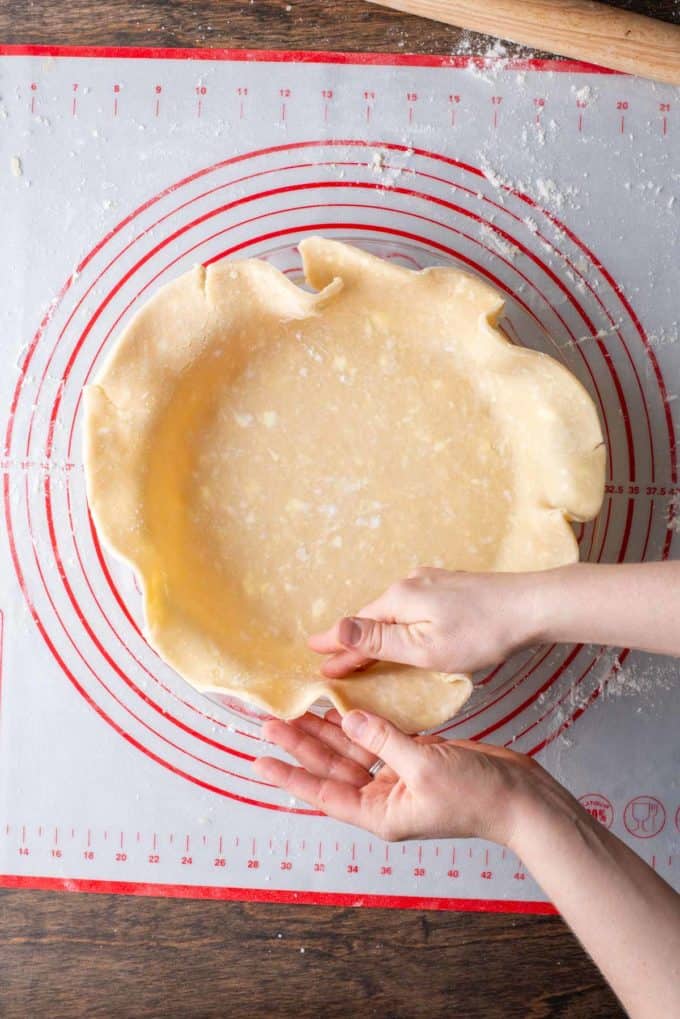
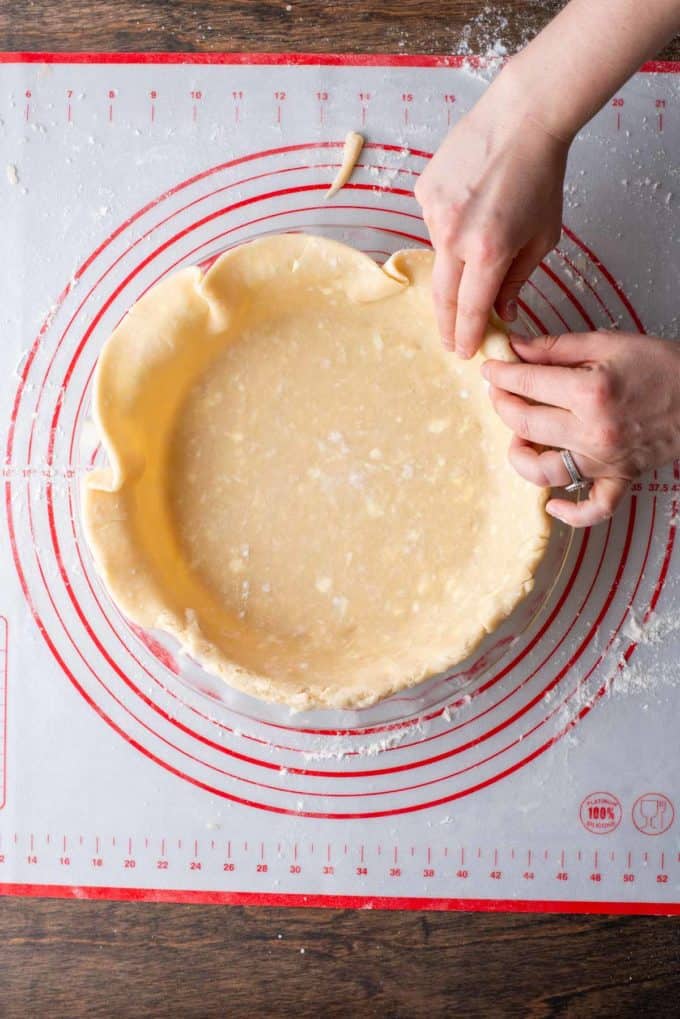
- Fold Under the Overhang: Start by folding the excess dough under itself. This creates a thick, double layer of dough around the edge of the pie dish. It also helps to reinforce the edge and create a more substantial crust.
- Flute the Edges: Using your thumb and pointer finger on one hand and your pointer finger on the other hand, pinch the folded edge of the dough together. Hold your fingers perpendicular to the edge of the crust. Continue pinching at regular intervals along the edge. As you pinch, press the dough between your fingers gently. You can create various crimp patterns, such as small points or scallops, depending on your preference.
- Final Touches: After you’ve crimped the entire edge, take a moment to go back and adjust any areas that might need a bit more attention. Make sure the edge is sealed securely.
Chill or Bake as Directed: Depending on your pie recipe, you may need to chill the pie crust or proceed directly to baking. Follow the specific instructions for your pie filling and baking time and temperature.
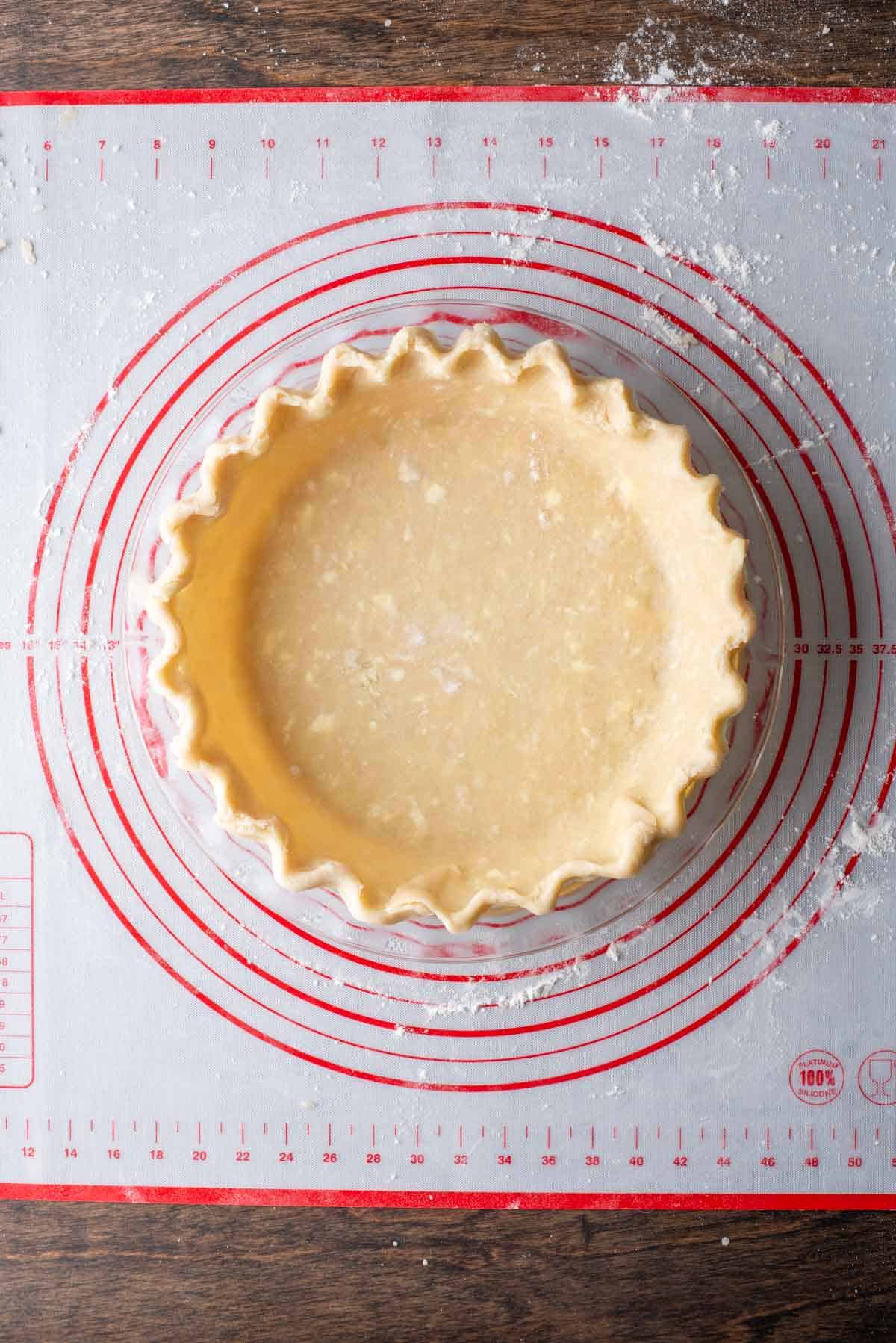
How to Crimp Pie Crust
Crimping or fluting a pie crust refers to the different methods of essentially designing the edges of the pie crust. Before you finish the edges of the crust, follow these steps:
- Prepare Your Pie Dish: Ensure that your rolled-out pie dough is in the pie dish and that it overhangs the edges.
- Trim Excess Dough: Trim any excessive overhang off the sides of the pie plate from the dough, leaving about 1/2 to 1 inch of overhang all around the pie dish. You can use scissors or a knife to do this.
- Fold Under the Overhang: Start by folding the excess dough under itself. This creates a thick, double layer of dough around the edge of the pie dish. It helps reinforce the edge and provides a base with enough dough for the crimping or fluting.
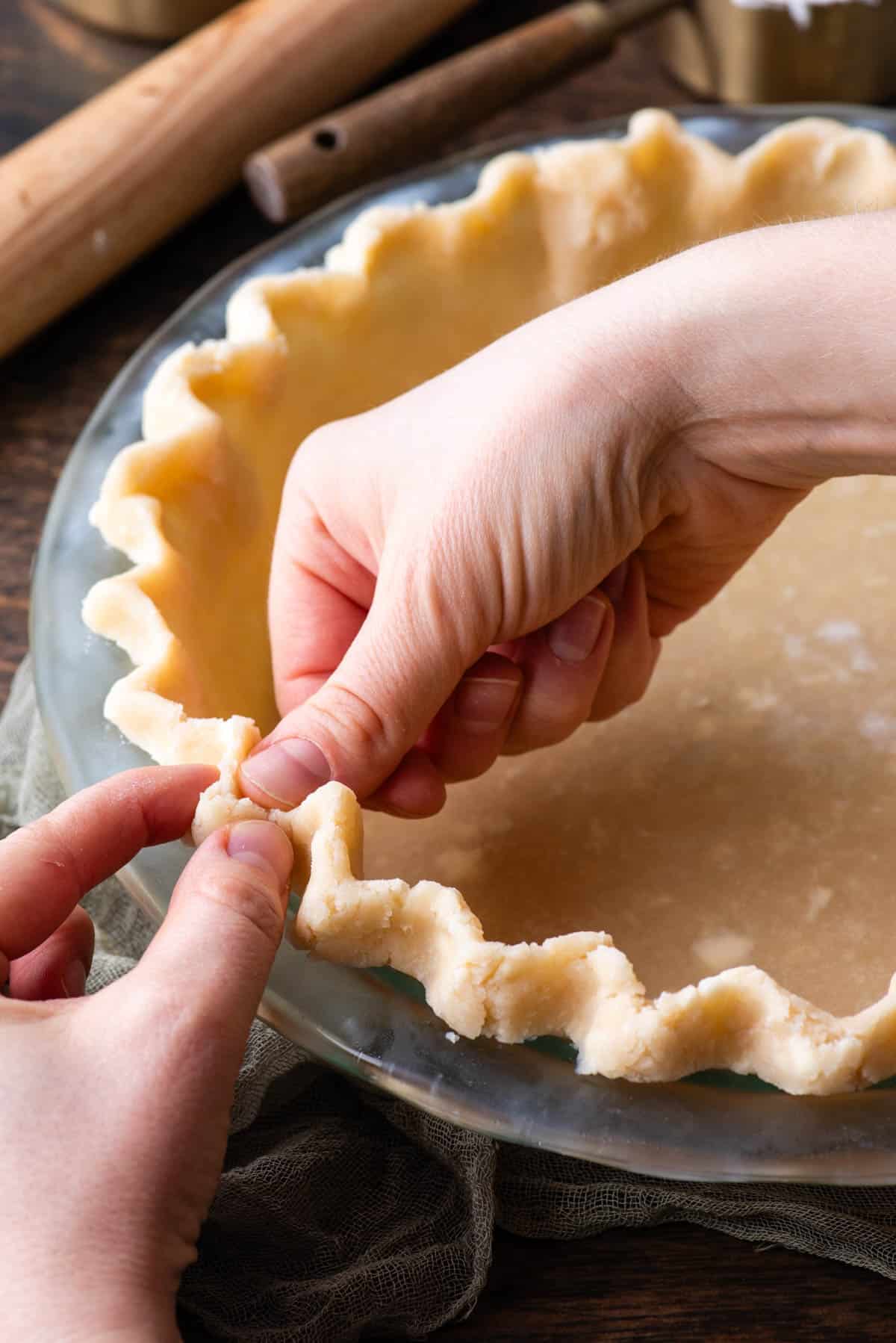
Crimping Method 1: Fluted Edge
There are several different ways to finish pie crust, but the most classic is fluting. To flute the pie crust:
- Use your thumb and pointer finger of one hand to create a V shape.
- With the pointer finger of your other hand, press the V-shaped dough gently to create a flute.
- Continue making these flutes evenly spaced around the entire circumference of the pie crust.
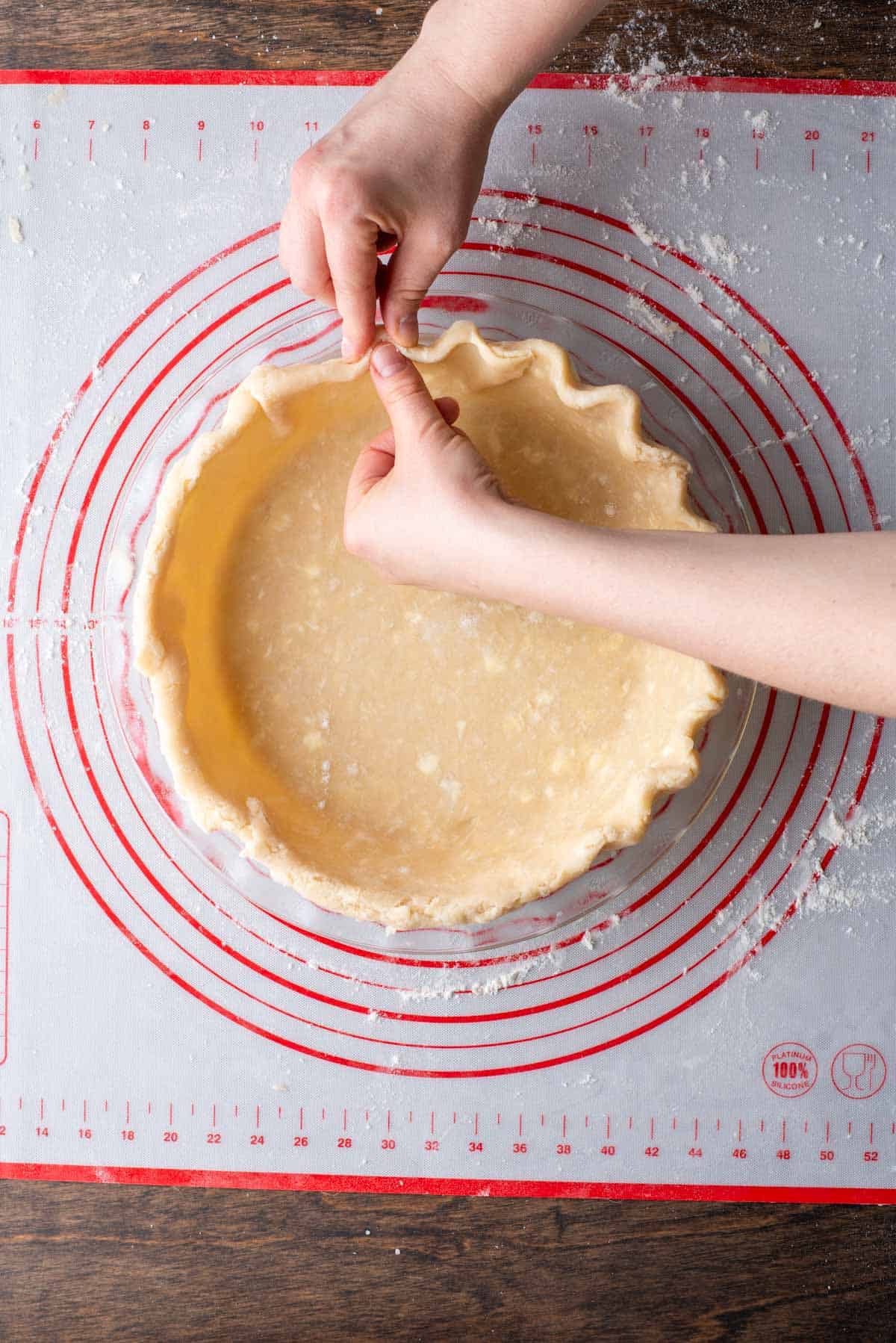
Crimping Method 2: Crimped Edge with a Fork
Crimping is traditionally done with a fork, creating a pattern around the edge of the pie. To crimp the pie crust:
- Use a fork to gently press lines around the edges of the pie crust.
- To avoid tearing through the dough, be sure not to press too hard.
- Continue this pattern around the entire circumference of the pie crust.
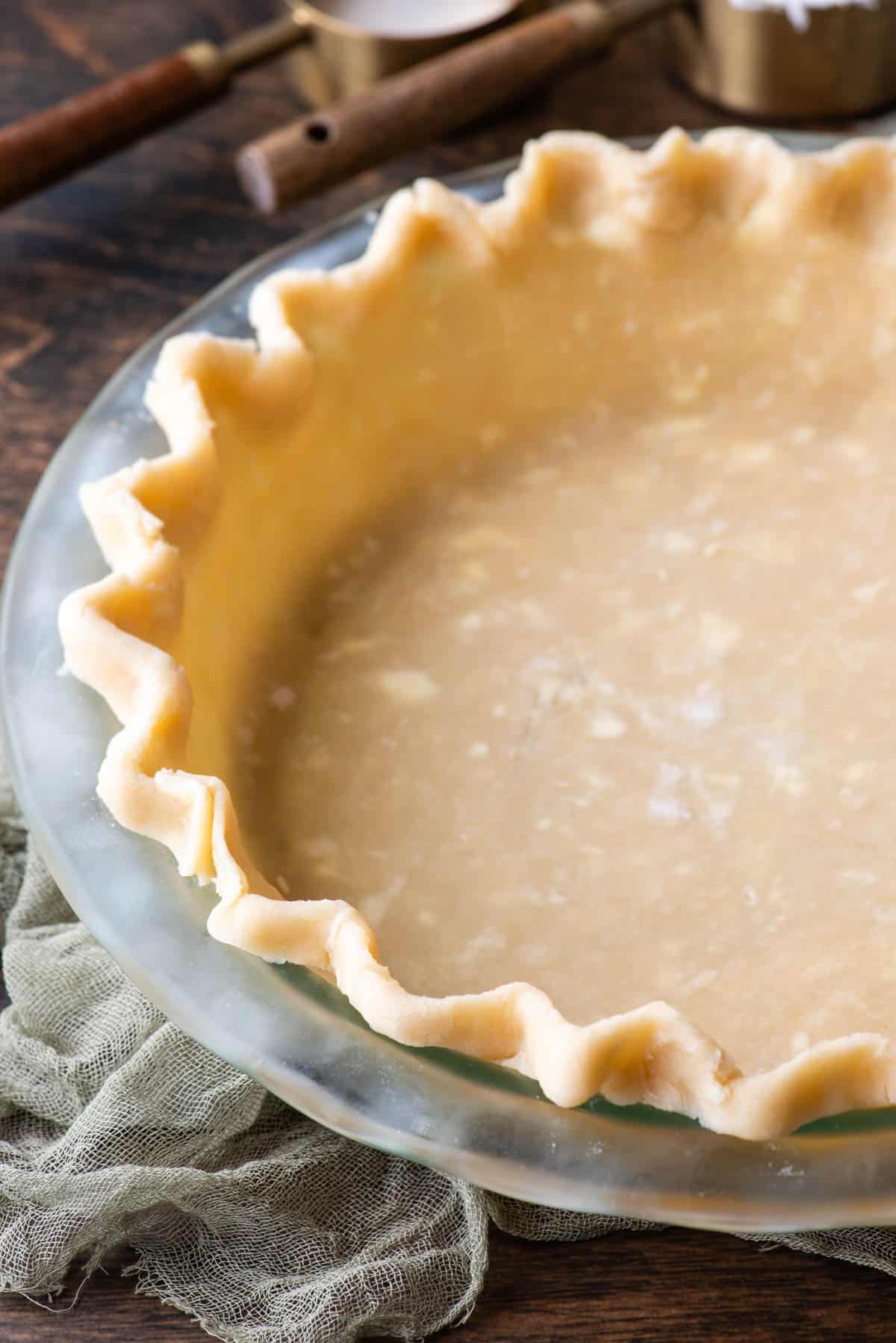
Tips For Making The Best Gluten Free Pie Crust
You’ll never need to buy a store-bought crust again. After you try this recipe once, you’ll feel confident in making your own gluten free crust at home. Here are some extra tips for the best pie crust:
- Keep Ingredients Cold: One of the most crucial factors for flaky crust is to keep your ingredients as cold as possible. Use cold butter, cold shortening, and ice-cold water. Cold butter creates steam as the pie bakes in the oven and the butter melts, which is what leads to flaky texture.
- Use a Food Processor: Through my testing, I found it easiest to use a food processor to assemble the dough. It yields consistent results and it’s quicker than using a pastry cutter. The food processor breaks the butter and shortening into equal uniform-sized pieces while the pastry cutter is more organic and uneven. I also found that butter pieces that were a quarter size or larger made it difficult for me when rolling the dough and transferring. The dough was more likely to break at those spots.
- Handle the Dough Gently: When shaping the dough into a disc/dough ball, be gentle. Don’t knead it like bread dough. Overworking the dough can make it tough and less flaky.
- Don’t Over Mix: Mix the dough just until it comes together. Over-mixing can result in a tougher crust. You should still see small pea-sized bits of butter in the dough.
- Beginner’s Trick: Even though my dough recipe makes enough for 2 pies, for a beginner learning how to make pie crust, I preferred keeping the dough together as one disc. When you start this way, it gives you more dough to work with, which allows you to have more dough for fluting the edges. Then, as you get better at making homemade pie crust you will feel more confident dividing the dough in half and rolling it out thinner.
- Use a Pie Mat: Using a pie mat was so helpful to me to see exactly what size my pie crust needed to be. I found it really helpful to cut my crust into a perfect circle using a pizza cutter and the lines on the mat. I think this was a game-changer for me. It was easier to roll the dough onto my rolling pin when it was a perfect circle.
- Cracking dough is normal: Your dough will crack and split when you start to roll it. This is normal. Simply use your hands to pinch it back together, You can also use your fingers to gently shape the outside edges into a more uniform shape.
- Use a tapered rolling pin: I originally started with an old-school dowel rolling pin but after a friend recommended it, I tried a tapered rolling pin and much preferred that. With the dowel rolling pin, I seemed to be rolling the edges too thin. Rolling out dough uniformly can be more challenging when using a dowel rolling pin due to the reduced leverage experienced at the edges.
- Position Baking Racks Correctly: Rearranging the baking racks in your oven so that you can place the pie on the lowest baking rack will help the crust fully cook. I learned this through trial and error. I started with my rack in the middle of my oven, but my pies kept coming out with the center of the crust uncooked.
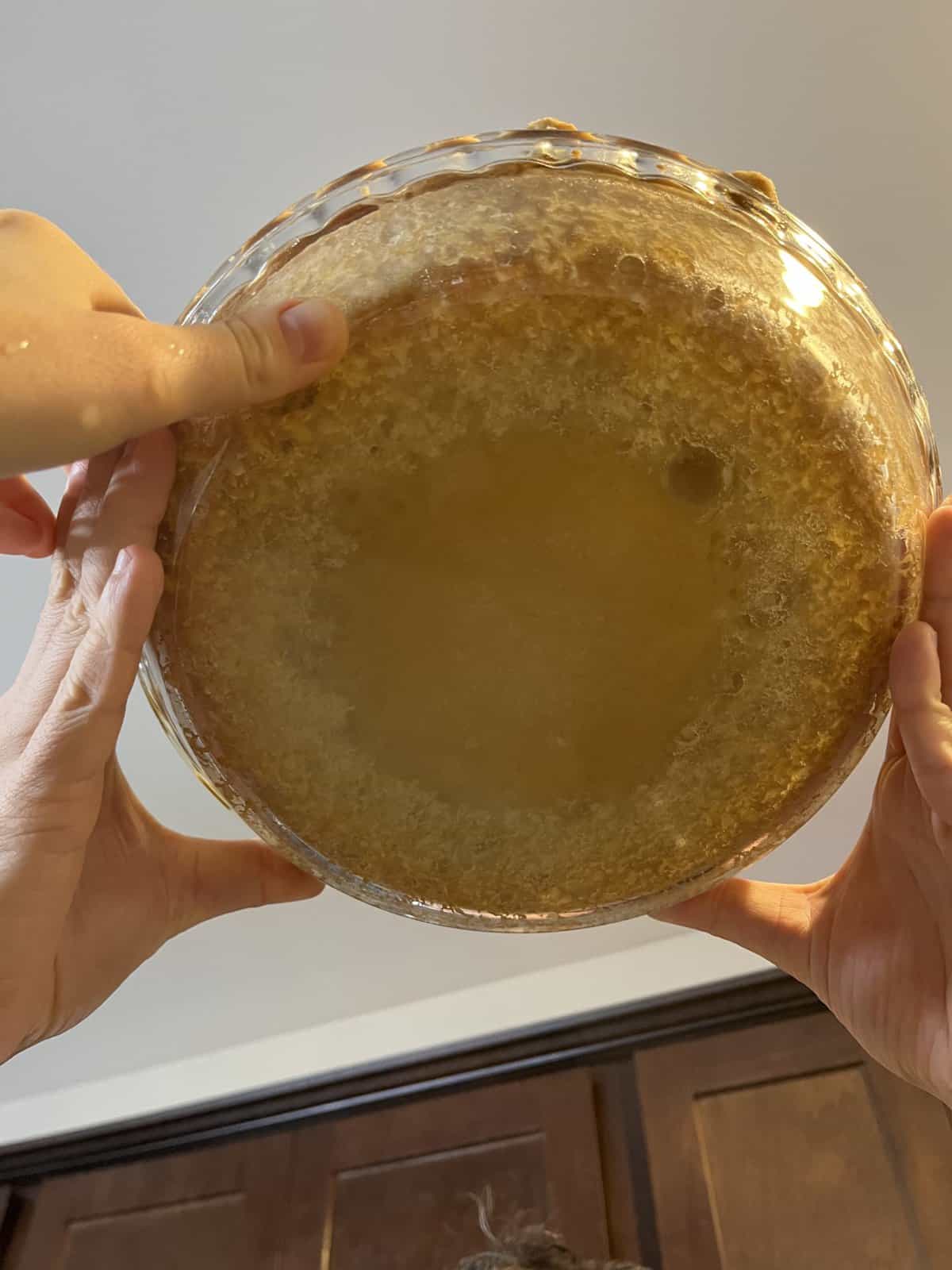
How do you keep a gluten free pie crust from falling apart?
To keep gluten free pie crust from falling apart, you must use the right amount of water. Too little water will result in a crumbly dough, and too much water will result in a sticky dough.
Only add enough ice-cold water to bring the dough together. Start with the recommended amount in your recipe (I use 4-5 tablespoons of ice water in this recipe) and add more if needed. While testing, I found that I typically used 4-5 tbsp of water when assembling the dough in the food processor and used more when using the pastry cutter or mixing with a spatula. The variation was likely because I wasn’t incorporating the water as evenly when mixing by hand.
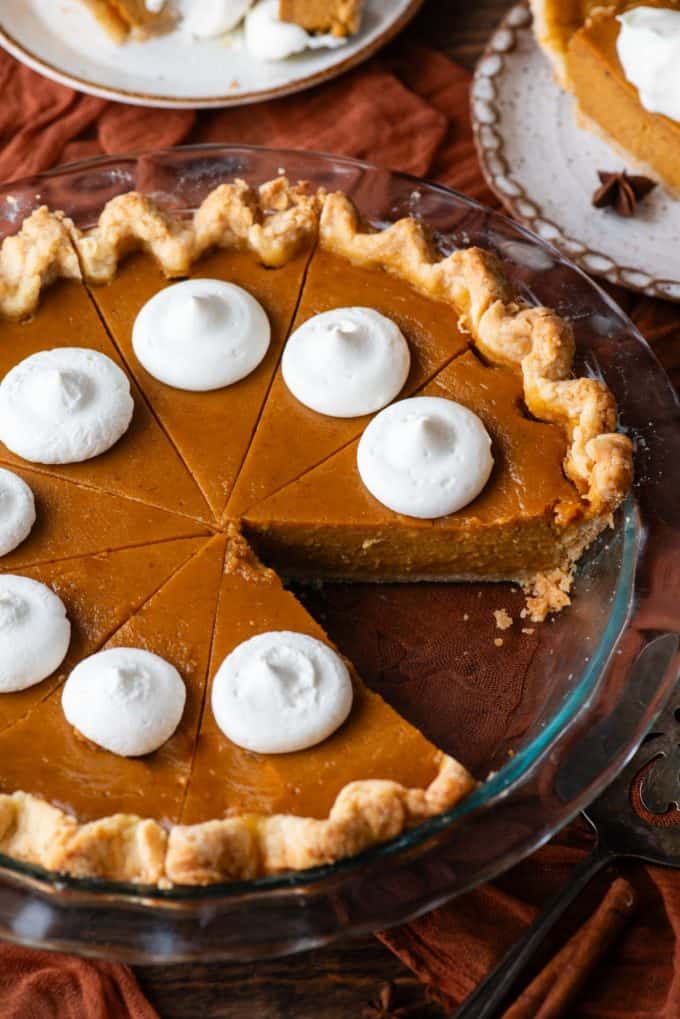
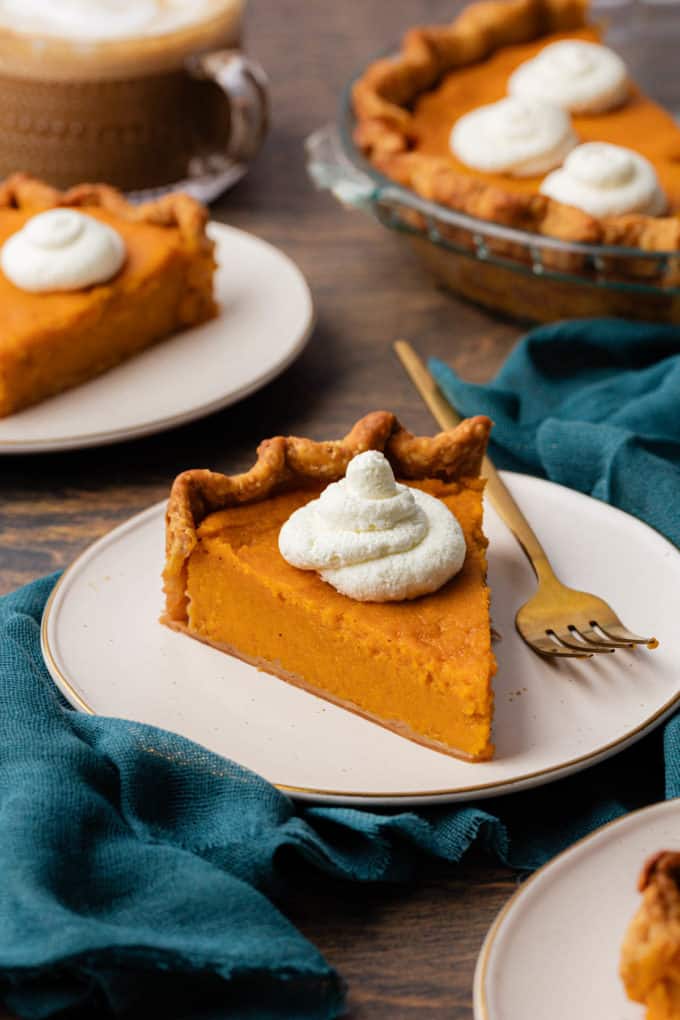
Ways to use this recipe for Gluten Free Pie Crust
You can use this pie crust for any sweet or savory pies, but here are some of my favorites:
- Gluten Free Coconut Cream Pie
- Homemade Pumpkin Pie Recipe
- Gluten Free Apple Pie
- Gluten Free Cherry Pie
Best Sweet Potato Pie Recipe - Gluten Free Blueberry Pie
- Gluten Free Dutch Apple Pie
How to Store Gluten Free Crust For Pie
If not using right away, you can refrigerate the discs of gluten free pie dough for up to 4 days. You can also freeze the discs of gf pie dough in an airtight container for up to 6 months.
Troubleshooting Your Gluten Free Crust For Pie
The most common reasons that a gluten free pie crust come out too hard are over-cooking or too much flour. Be sure to use the exact amount of gluten-free flour blend recommended in the recipe, and cook for the recommended time.
Gluten free pie crust may become crumbly if too much flour or not enough water is used. Be sure to use the exact amount of gf flour recommended in the recipe and follow the tips above to use the right amount of water.
Xanthan gum contributes to creating a smoother and softer texture in the dough. That’s why it is important to use a high quality gluten free flour that contains xanthan gum. I recommend King Arthur Gluten-Free Measure for Measure flour.
Try your hand at gluten free pizza dough!
More Pie Recipes
- Easy Peanut Butter Pie
- Eggnog Pie
- Chocolate Cream Pie with Pudding
- Reese Peanut Butter Cup Pie
- No Bake M&M Pie
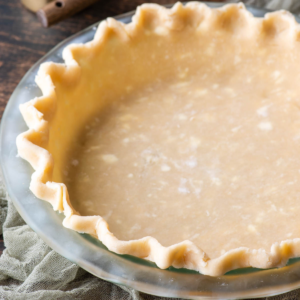
Tap stars to rate!
Recipe For Gluten Free Pie Crust
Equipment
- Pizza Cutter
- Rolling Pin
Ingredients
- 2 ½ cups (300g) Gluten Free All-purpose flour
- 1 tsp salt
- 1 Tbsp granulated sugar
- 6 Tbsp (86g) cold unsalted butter
- ⅔ cup (129g) vegetable shortening, chilled
- ½ cup (118ml) ice cold water, I typically only use 4-5 tablespoons

Instructions
- Chill the Butter and Shortening: Start by cutting the butter and shortening into small cubes. Place in a container or on a plate and put in the fridge to chill for at least 30 minutes. I recommend using shortening sticks so it's easier to cut into pieces. If using a tub of shortening, you can portion the ⅔ cup into about tablespoon size pieces.6 Tbsp (86g) cold unsalted butter, ⅔ cup (129g) vegetable shortening
- Combine Dry Ingredients: In the food processor, add the 2 1/2 cups of all-purpose flour, 1 teaspoon of salt, and 1 tablespoon of granulated sugar. Pulse a few times to combine the dry ingredients.2 ½ cups (300g) Gluten Free All-purpose flour, 1 tsp salt, 1 Tbsp granulated sugar
- Add Butter and Shortening: Add the 6 tablespoons of cold unsalted butter cubes and the chilled vegetable shortening chunks into the food processor. Pulse until the mixture resembles coarse crumbs with some pea-sized pieces of butter and shortening remaining. This should take about 10-15 one-second pulses.
- Add Ice Water: drizzle in the ice-cold water, start with 4 tablespoons, continue processing until the dough begins to clump together. You can test the dough by pinching it; if it holds together, it's ready. If it's too dry, add more water, 1 tablespoon at a time, and pulse briefly until the dough reaches the right consistency.½ cup (118ml) ice cold water
- Form Dough: Turn off the food processor and carefully remove the dough from the bowl. Place it onto a clean surface, such as a large piece of plastic wrap.
- Shape into Discs: Divide the dough into two equal portions. Shape each portion into a flat disc. This makes it easier to roll out later. Wrap each disc tightly in plastic wrap and refrigerate for at least 60 minutes or until firm. You can refrigerate for up to 4 days. You can also freeze one of the discs for future use if you're only making a single-crust pie.
- Prepare Your Work Surface: Ensure your countertop or pie mat is clean and dry. Lightly dust it with all-purpose flour to prevent sticking.
- Take Out Chilled Dough: Remove one of the chilled dough discs from the refrigerator and let it sit at room temperature for a few minutes. This will make it easier to roll.
- Begin Rolling: Place the dough disc on the floured surface and use your rolling pin to gently press it down in the center. Start rolling from the center outward. Apply even pressure as you roll, working in all directions to maintain a roughly circular shape. If the dough cracks or splits during the rolling process, use your fingers to gently pinch it back together.
- Rotate the Dough: After each roll, rotate the dough a quarter turn. This helps ensure an even thickness and round shape, and prevents the dough from sticking to the surface. Continue rolling and rotating until the dough is about 6 inches in diameter.
- Flip and Dust with Flour: Gently lift the dough from the surface using your hands, and flip it over. This prevents sticking and ensures even rolling. If the dough feels sticky, lightly dust it with more flour.
- Continue Rolling: Resume rolling from the center outward, rotating the dough as needed. Aim for an even thickness and gradually work your way to your desired size, typically 11-12 inches in diameter for a standard pie dish.
- Use a Pizza Cutter (Optional): For a perfectly round shape, consider using a pizza cutter. Place the cutter's wheel at the edge of the dough, and cut around the perimeter to trim it into a precise circle. This also helps you visualize the exact size needed for your pie pan.
- Sprinkle with Flour: To prevent the dough from sticking to itself when rolled onto the rolling pin, sprinkle a little more flour over the surface of the dough.
- Roll onto Rolling Pin: Carefully lift one edge of the dough and gently roll it onto your rolling pin. Start from one edge and continue rolling until the entire circle is wrapped around the rolling pin.
- Transfer to Pie Dish: Position the dough-covered rolling pin over your pie dish with the edge of the dough hanging over the side. Gently unroll the dough from the rolling pin into the pie dish, ensuring it covers the bottom and sides evenly.
- Trim Excess Dough: Trim any excessive overhang from the dough, leaving about 1/2 to 1 inch of overhang all around the pie dish. You can use scissors or a knife to do this.
- Fold Under the Overhang: Start by folding the excess dough under itself. This creates a thick, double layer of dough around the edge of the pie dish. It also helps to reinforce the edge and create a more substantial crust.
- Flute the Edges: Using your thumb and pointer finger on one hand and your pointer finger on the other hand, pinch the folded edge of the dough together. Hold your fingers perpendicular to the edge of the crust. Continue pinching at regular intervals along the edge. As you pinch, press the dough between your fingers gently. You can create various crimp patterns, such as small points or scallops, depending on your preference.
- Final Touches: After you've crimped the entire edge, take a moment to go back and adjust any areas that might need a bit more attention. Make sure the edge is sealed securely.
- Chill or Bake as Directed: Depending on your pie recipe, you may need to chill the pie crust or proceed directly to baking. Follow the specific instructions for your pie filling and baking time and temperature.
